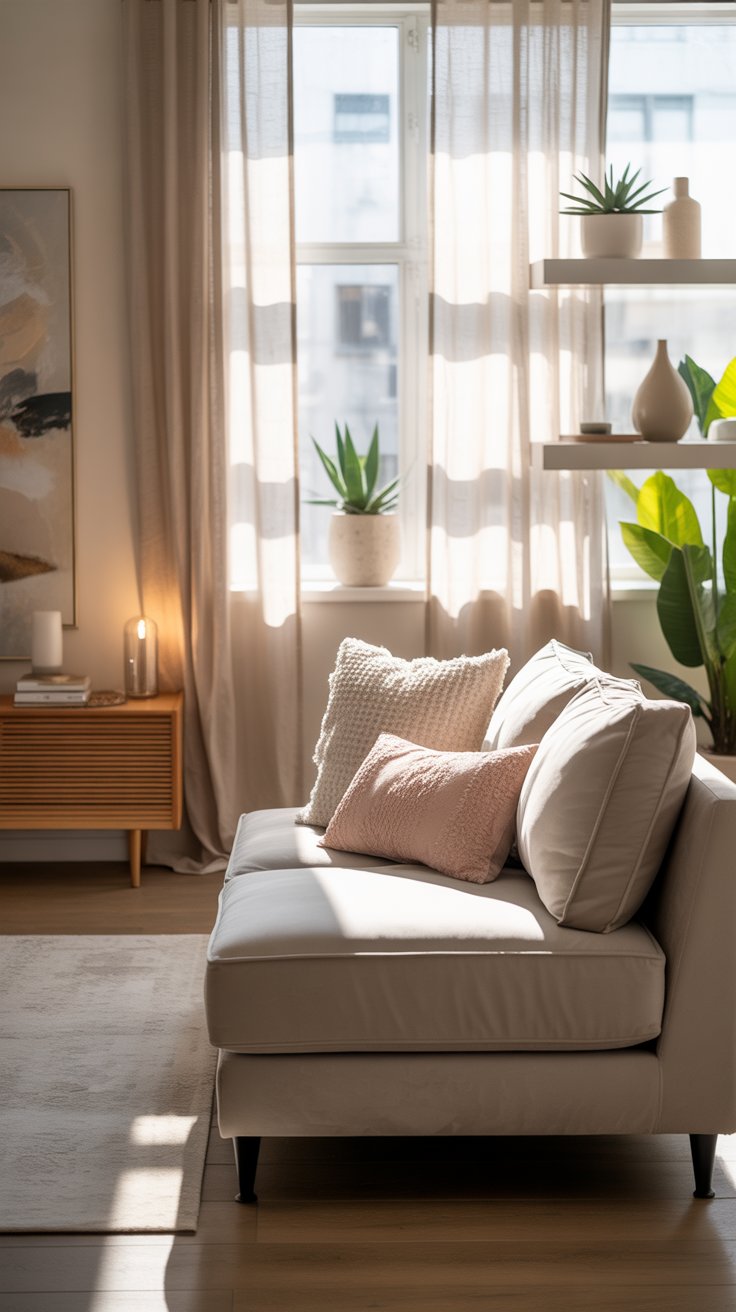
Small Apartment Interior Ideas: Stylish & Space-Saving Inspiration
Living in a compact space doesn’t mean you have to sacrifice comfort or style. With thoughtful design and clever organization, small apartment interior can feel just as inviting and functional as a larger home. Whether you prefer modern minimalism, cozy boho vibes, or practical multi-functional furniture, there are endless ways to transform a small apartment into a stylish haven.
In this guide, we’ll explore space-saving hacks, interior design ideas, and decor tips to maximize your apartment. You’ll also find visual inspiration with image prompts that showcase different looks and layouts.
1. Maximizing Space with Smart Layouts
One of the biggest challenges in small apartment design is making the most of every inch. Strategic layouts are key. Consider furniture placement that opens up the room rather than blocking pathways. Floating furniture arrangements — such as a sofa placed away from the wall with a narrow console behind it — can create the illusion of more depth.
Using lightweight and modular furniture also allows flexibility. Foldable tables, stackable chairs, and nesting stools are perfect for small homes where adaptability matters.
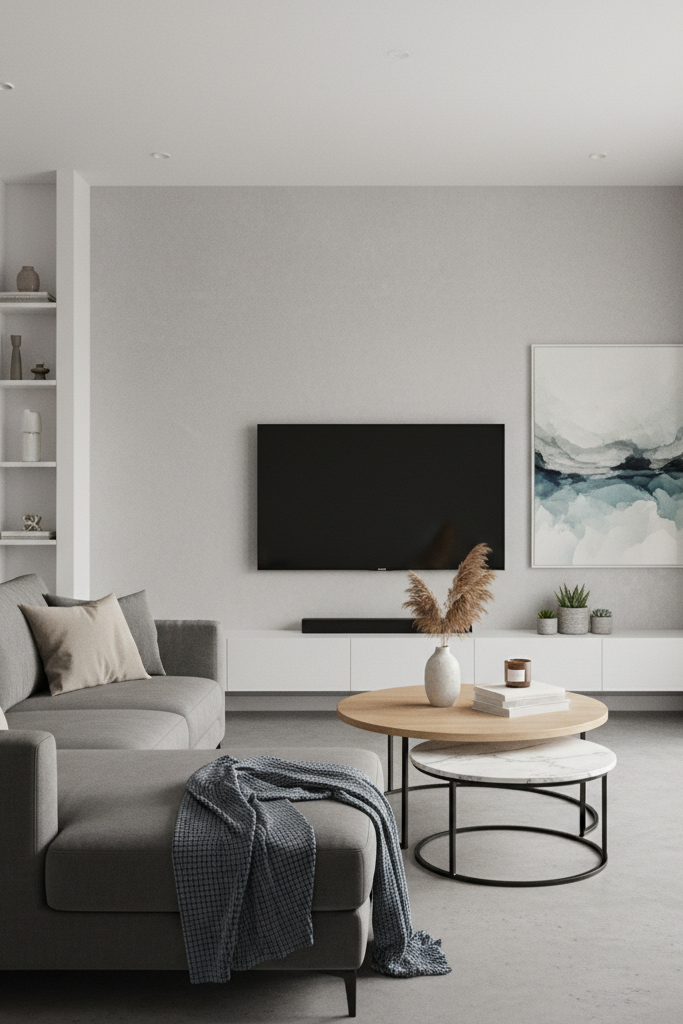
2. The Power of Multifunctional Furniture
When space is limited, multifunctional pieces become lifesavers. A sofa that doubles as a bed, a coffee table with hidden storage, or an ottoman that serves as extra seating — each piece can play multiple roles without taking up extra space.
Convertible furniture not only saves room but also keeps the apartment tidy and organized. This approach is especially useful in studio apartments, where living, dining, and sleeping areas often overlap.
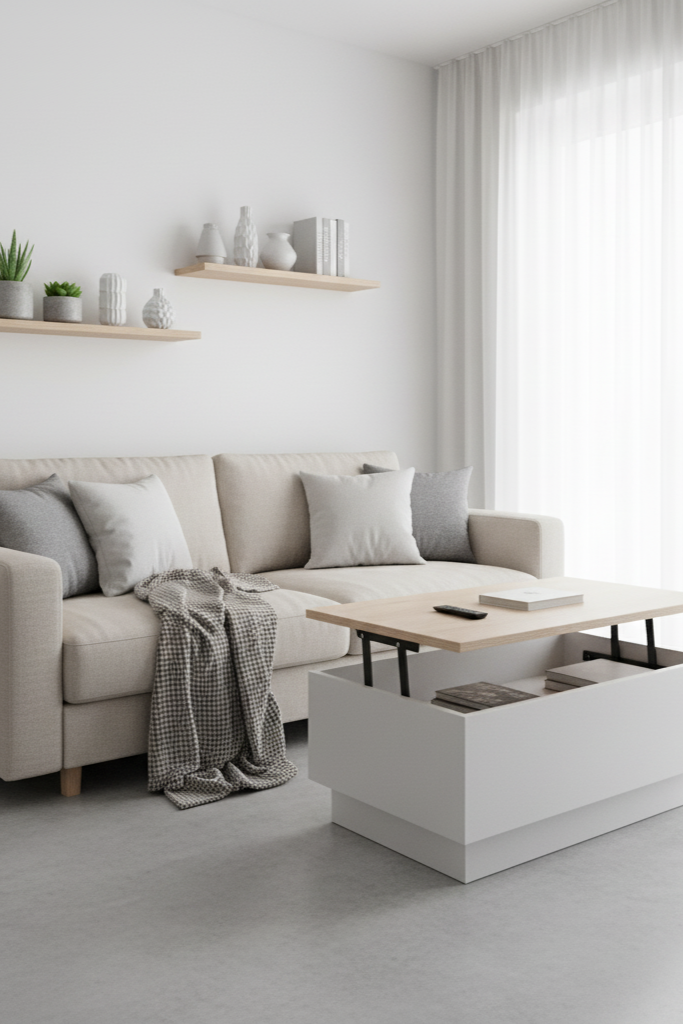
3. Creating Light & Airy Interiors
Lighting plays a crucial role in making small apartments appear larger. Natural light should be maximized with sheer curtains or blinds instead of heavy drapes. Mirrors can also reflect light, instantly making rooms feel more open.
When natural light is limited, layer artificial lighting with ceiling fixtures, floor lamps, and wall sconces to brighten dark corners. A balanced lighting scheme adds both warmth and dimension.
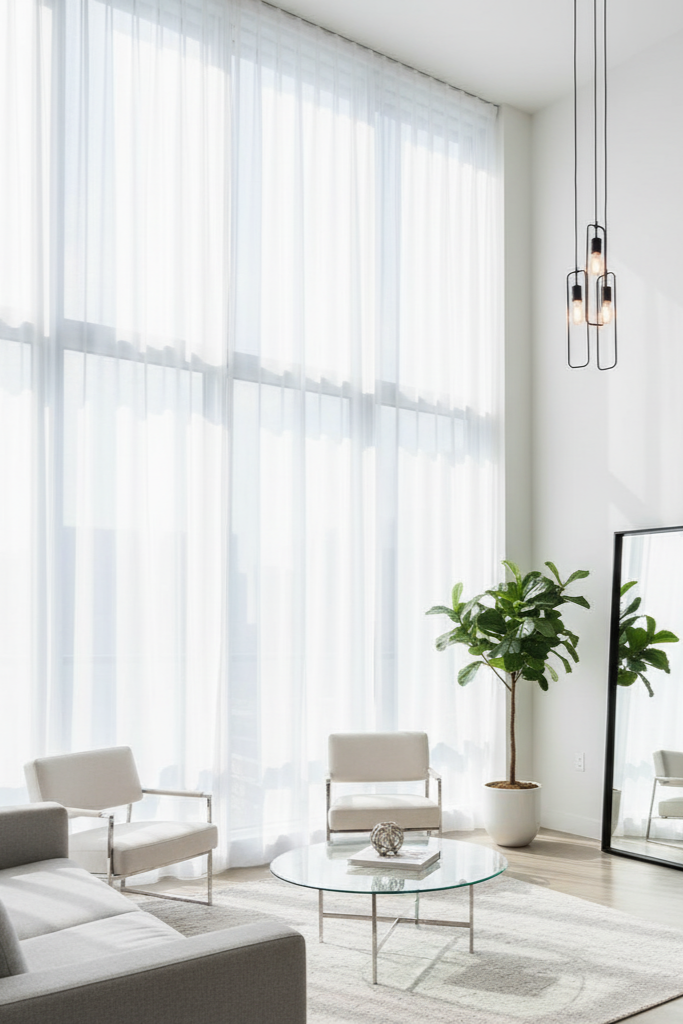
4. Embracing Modern Minimalism
For those who prefer a clean and uncluttered style, modern minimalism works beautifully in small apartments. Neutral tones, streamlined furniture, and limited decor items create an airy atmosphere.
Minimalist interiors often lean on functionality — every piece is intentional, from sleek open shelving to low-profile sofas that don’t overwhelm the space. Scandinavian-inspired decor is a popular choice for this look.
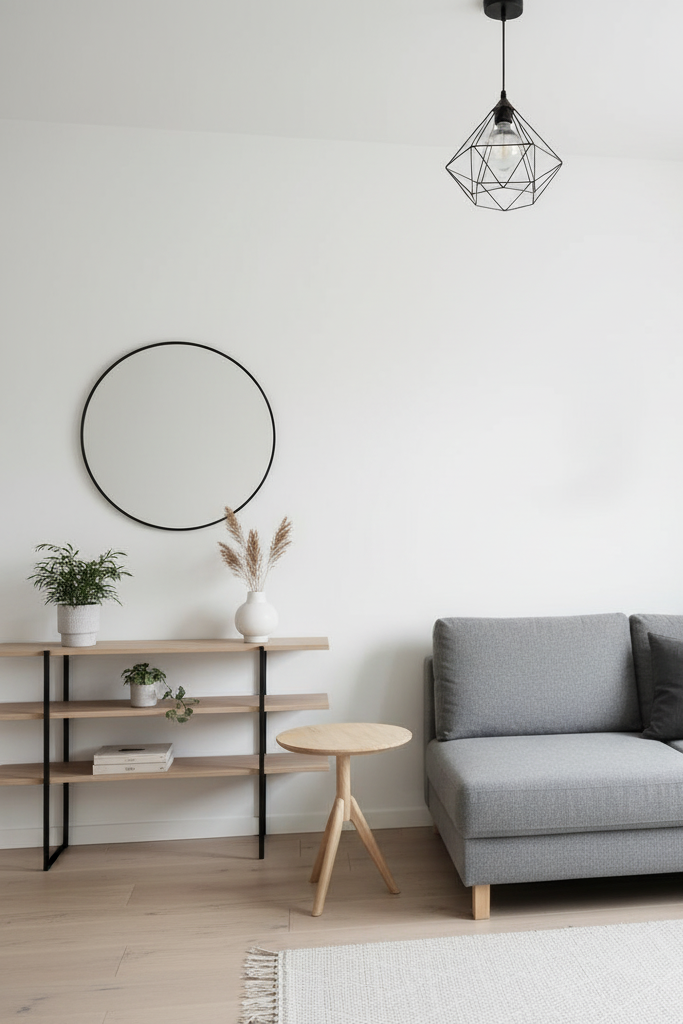
5. Warm & Inviting Design
Not every small apartment has to look stark and minimal. Warm interiors bring comfort through textures, earthy colors, and layered lighting. Adding warm neutrals like terracotta, mustard, and beige can make a space feel instantly cozy.
Boho-inspired details — rattan furniture, woven rugs, and hanging lights — create a welcoming and relaxed vibe.
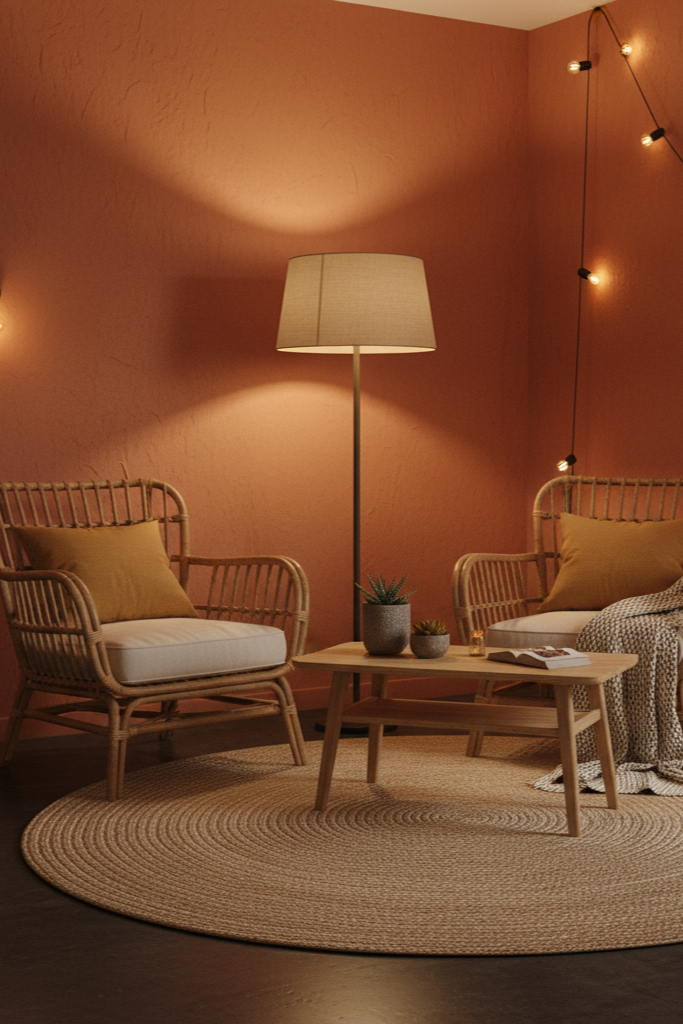
6. Vertical Storage Solutions
Storage is often the biggest struggle in small apartment interiors. Vertical storage is the answer. Wall-mounted shelves, tall cabinets, and ladder-style shelving units allow you to keep essentials without eating into floor space.
Floating shelves above desks, beds, or sofas can hold books, plants, or decor items. This maximizes storage while keeping things visually appealing.
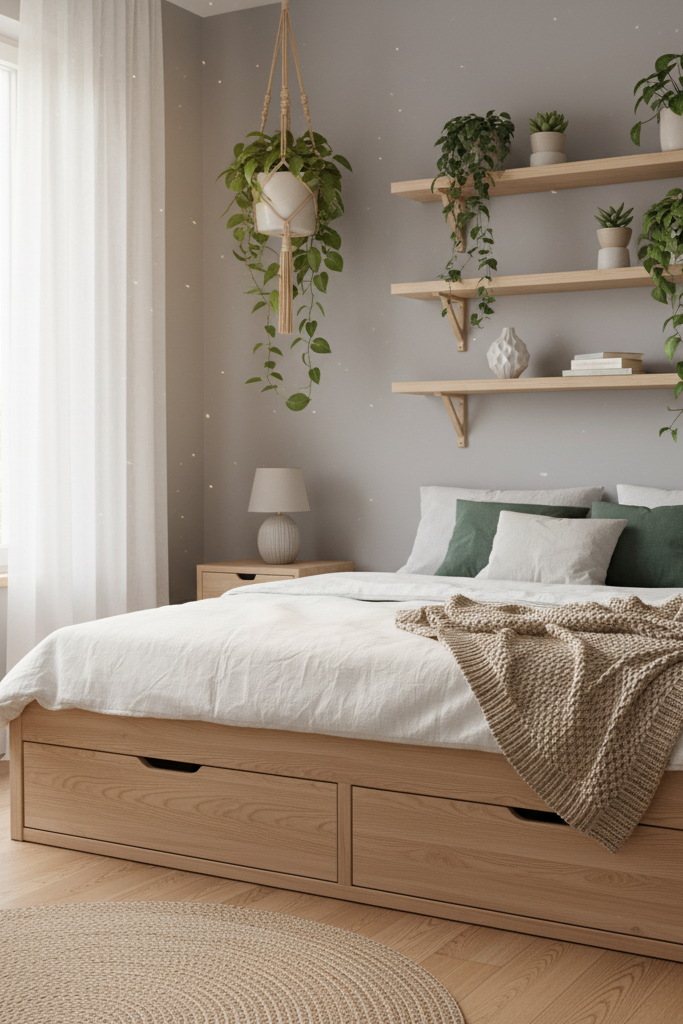
7. Adding Personality with Decor
Just because the apartment is small doesn’t mean it should lack character. Statement wall art, accent rugs, or bold cushions can all make a big impact. Choose a few standout pieces rather than cluttering the room with too many small items.
Plants are another great way to add personality and freshness. Hanging plants or small potted greenery bring life without taking up valuable surface area.
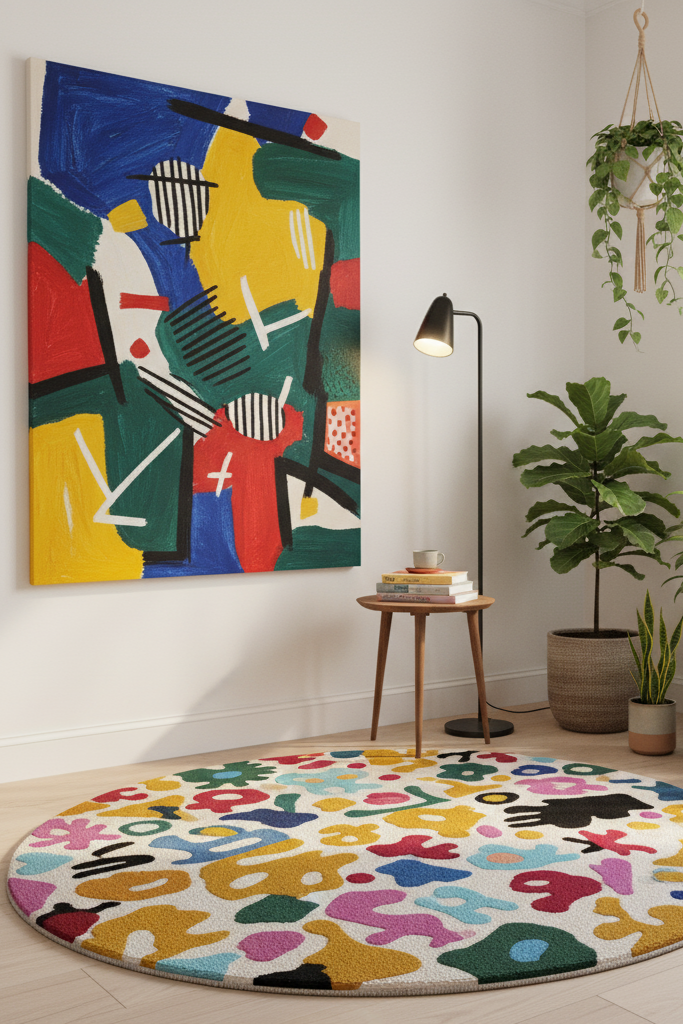
8. Space-Saving Kitchen & Dining Ideas
Kitchens and dining spaces in small apartments can benefit from foldable or extendable furniture. A wall-mounted fold-down dining table or a narrow breakfast bar with stools tucked underneath makes meals convenient without taking up too much room.
Open shelving in the kitchen can also keep things organized while maintaining an airy feel.
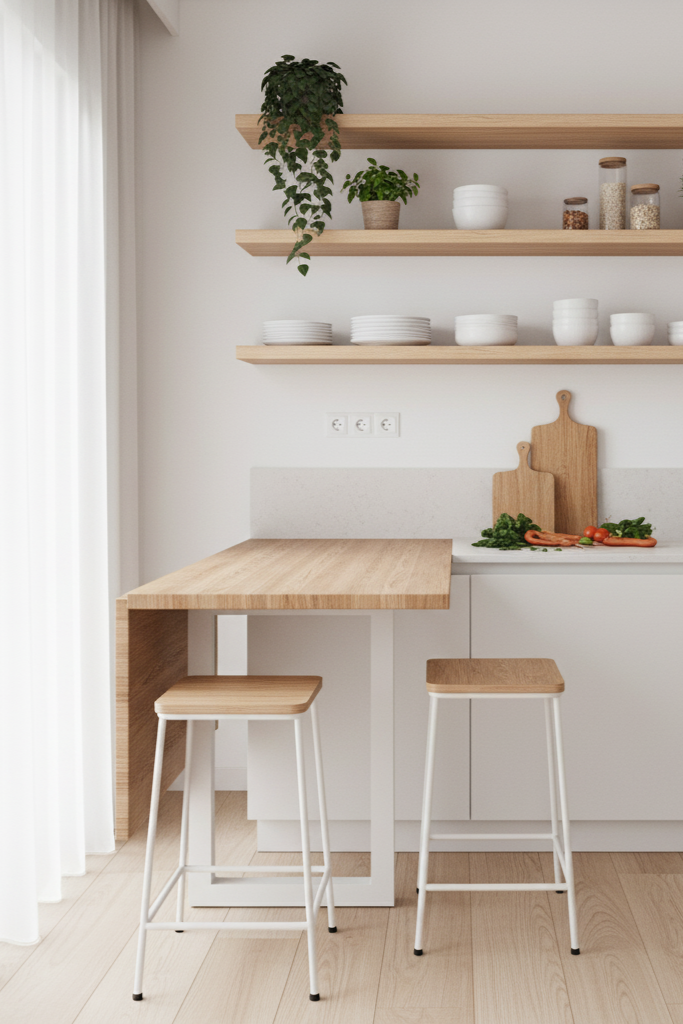
9. Creating a Relaxing Bedroom
Bedrooms should be restful, even in small spaces. Storage beds, soft bedding layers, and calming colors can create a peaceful retreat. Use wall-mounted nightstands or sconces instead of bulky furniture to free up floor space.
Mirrors on wardrobes or closet doors further enhance the illusion of spaciousness.
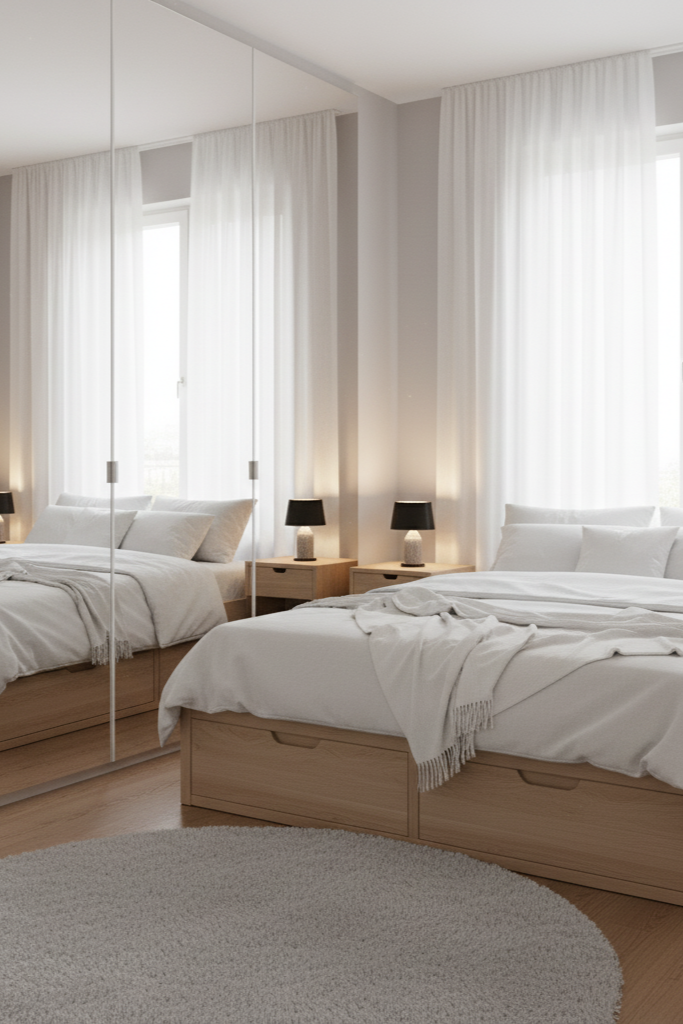
10. Blending Style with Function
The best small apartment interiors blend functionality with aesthetics. Every design choice should serve both a practical and visual purpose. For instance, a modular shelving unit can display decor while storing essentials, and a decorative ladder can hold throws or magazines.
By mixing style with practicality, even the smallest apartments can feel chic and comfortable.
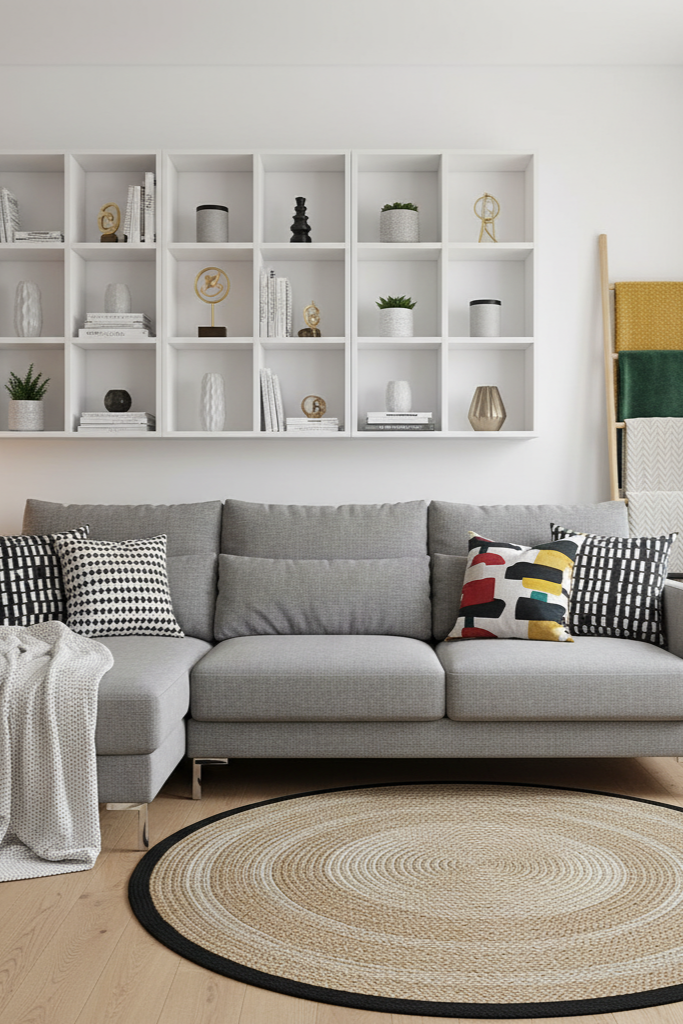
Conclusion
Designing a small apartment interior is all about creativity and efficiency. By focusing on multifunctional furniture, clever storage, warm or minimal aesthetics, and thoughtful layouts, you can make the most of limited square footage.
Whether you lean toward modern minimalism, cozy boho charm, or sleek multifunctional setups, small apartments offer plenty of room for design innovation. With the right approach, your space will feel bigger, brighter, and more stylish than ever.
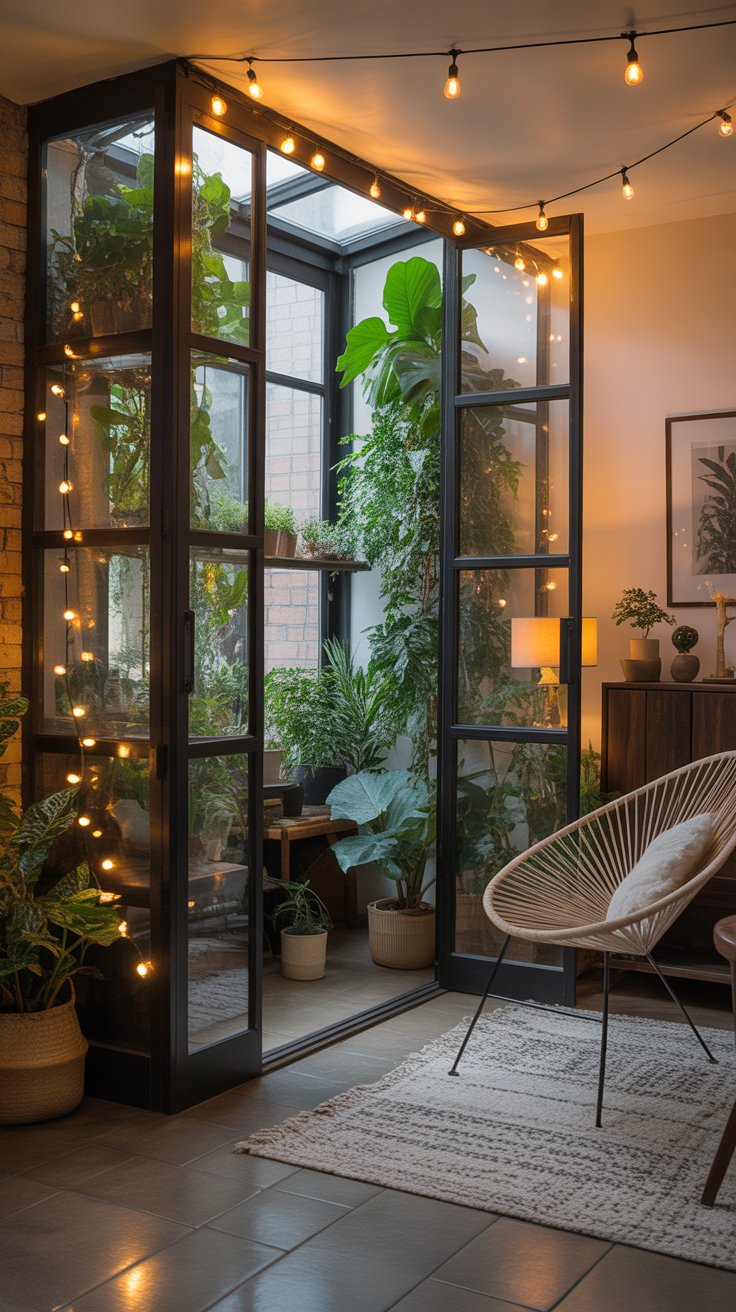
🌱 Greenhouse Set Up Inside: How to Create a Beautiful Indoor Green Space
Bringing nature indoors has become more than a trend—it’s a lifestyle. For plant lovers, creating a greenhouse set up inside your home is the ultimate way to surround yourself with greenery, fresh air, and natural beauty all year round. Whether you live in a small apartment or a spacious house, designing an indoor greenhouse is achievable and can transform your space into a cozy, vibrant, and refreshing retreat.
In this article, we’ll explore how to create a stunning indoor greenhouse, from functional setups to stylish design tips, and how to choose plants that thrive indoors. By the end, you’ll feel inspired to build your very own plant sanctuary right at home.
Why Create a Greenhouse Inside?
Indoor greenhouses are not just for serious gardeners. They are perfect for:
• Apartment dwellers who don’t have outdoor space.
• Plant parents who want to grow herbs, succulents, or tropical plants year-round.
• Decor lovers who want to blend greenery into their home aesthetic.
• Wellness enthusiasts who appreciate the calming benefits of plants.
A well-designed greenhouse set up inside can become the focal point of your home, balancing both functionality and beauty.
Choosing the Right Indoor Greenhouse Setup
When planning your greenhouse, think about the size of your space, the kind of plants you want to grow, and your home’s style. Here are popular options:
1. Greenhouse Cabinet
A glass-door cabinet transformed into a mini greenhouse is perfect for small spaces. With LED grow lights and adjustable shelves, you can grow herbs, ferns, or small houseplants while keeping everything tidy and stylish.
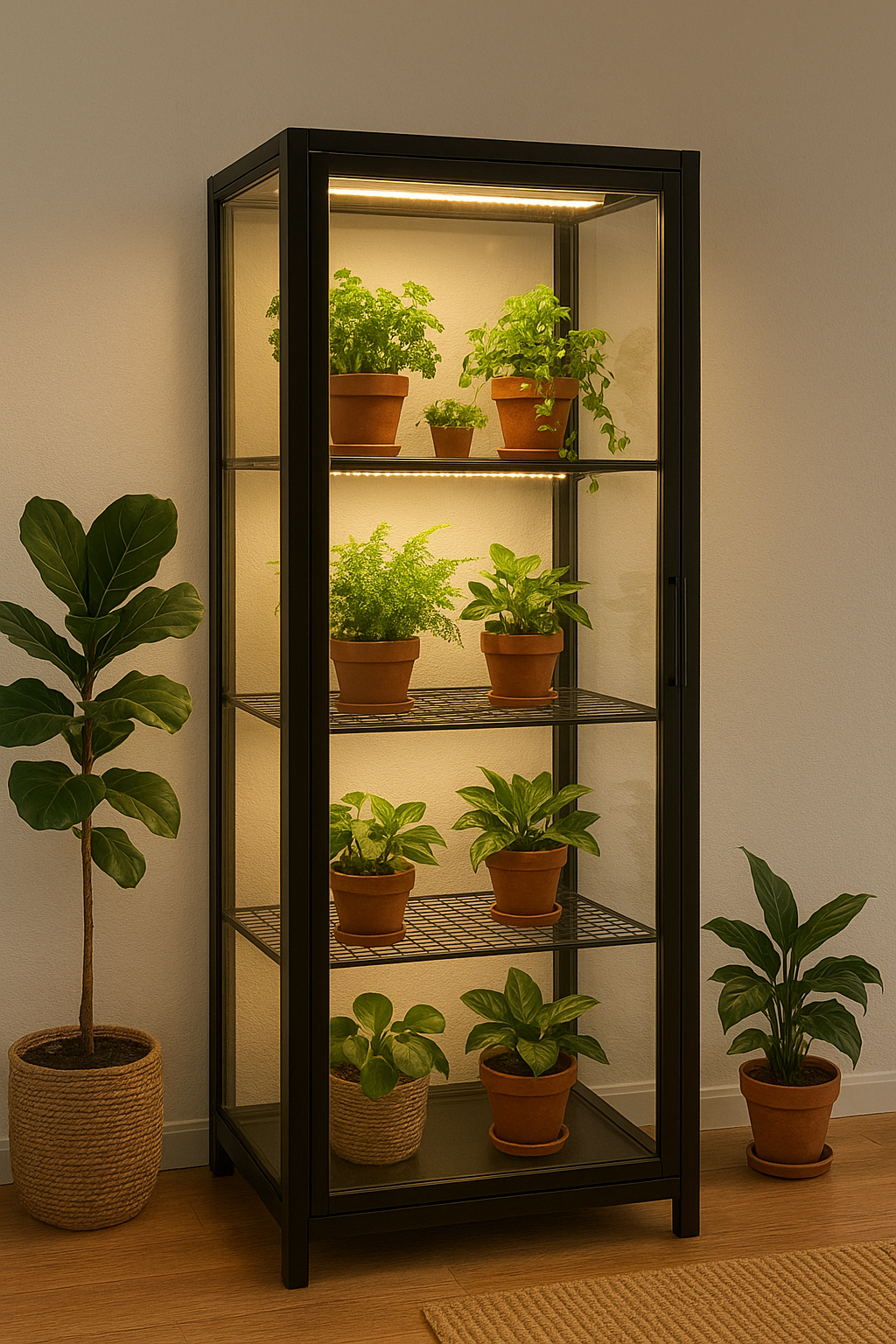
2. Corner Greenhouse
If you have unused corners in your home, turn them into mini jungle retreats with tiered plant stands, glass shelving, and hanging plants. Add string lights or a floor lamp to make it cozy.

3. DIY Shelf Greenhouse
Metal or wooden shelving with a transparent cover is a budget-friendly way to create an indoor greenhouse. This setup is functional and can be customized to fit your space.
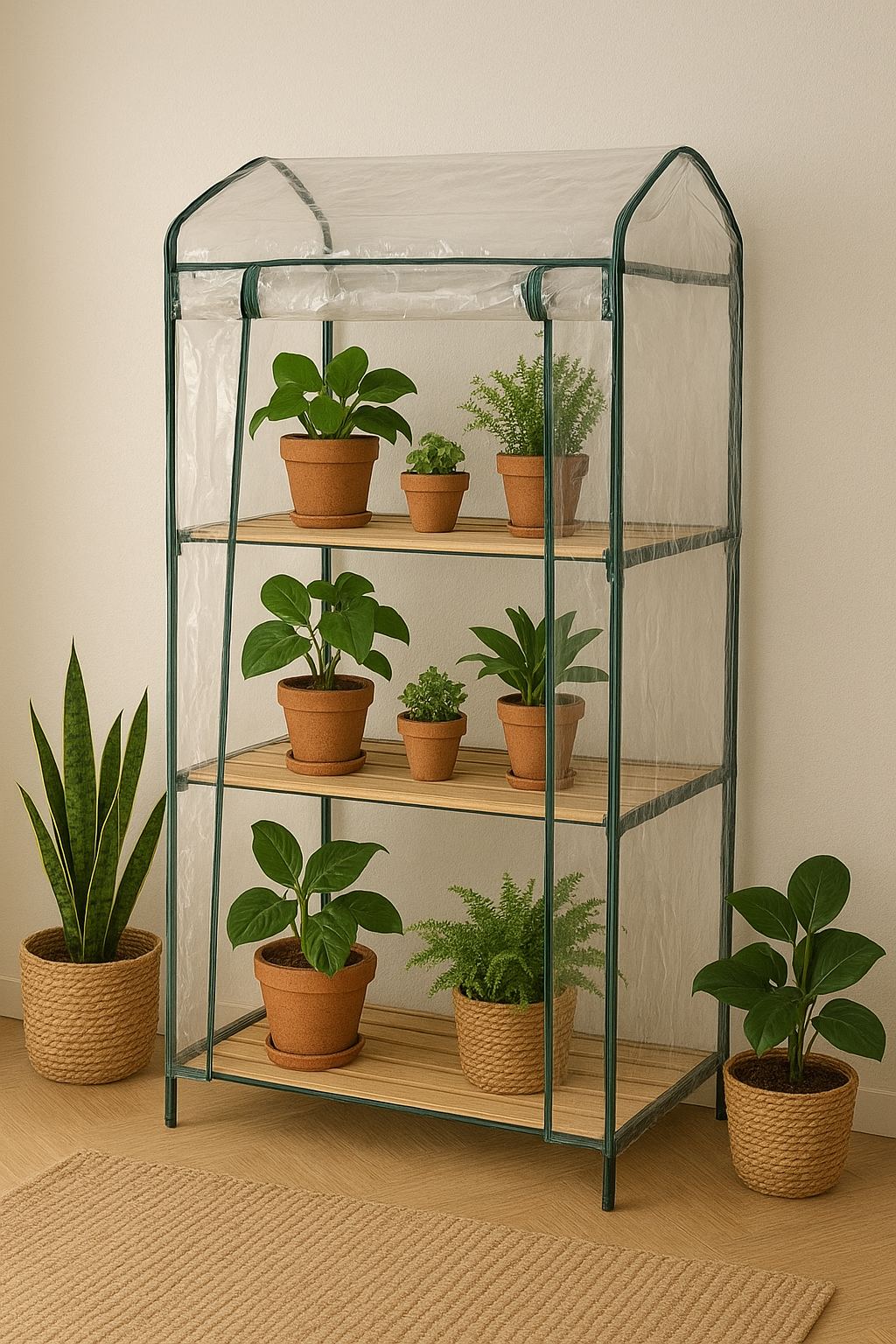
4. Boho-Inspired Greenhouse
For a cozy aesthetic, mix plants with woven baskets, macrame hangers, and earthy textures. This style blends perfectly with bohemian or eclectic interiors.
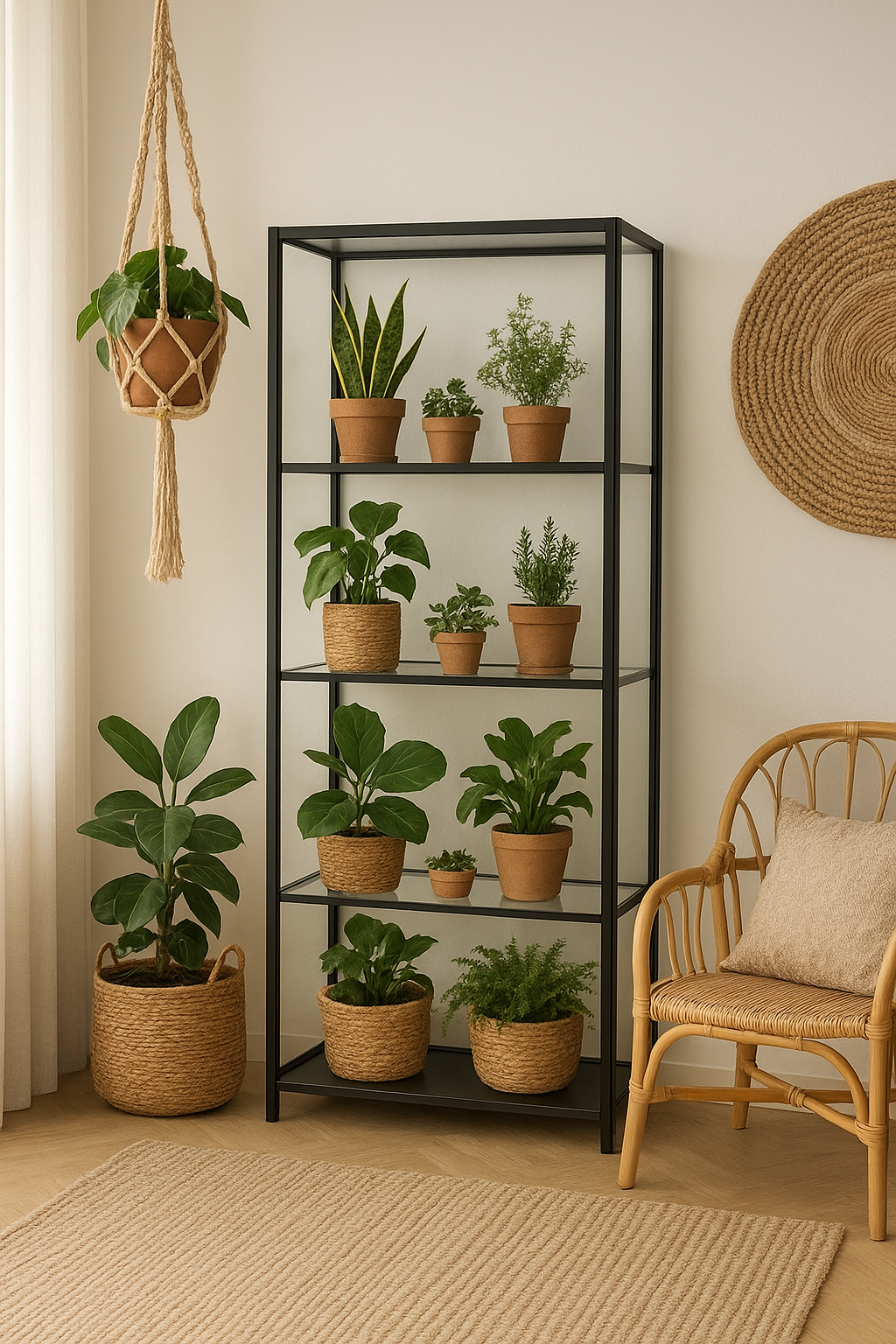
5. Minimalist Greenhouse
Prefer a modern look? Choose sleek black frames, glass shelves, and neatly arranged plants for a clean, clutter-free aesthetic. This fits perfectly in Scandinavian or minimalist homes.
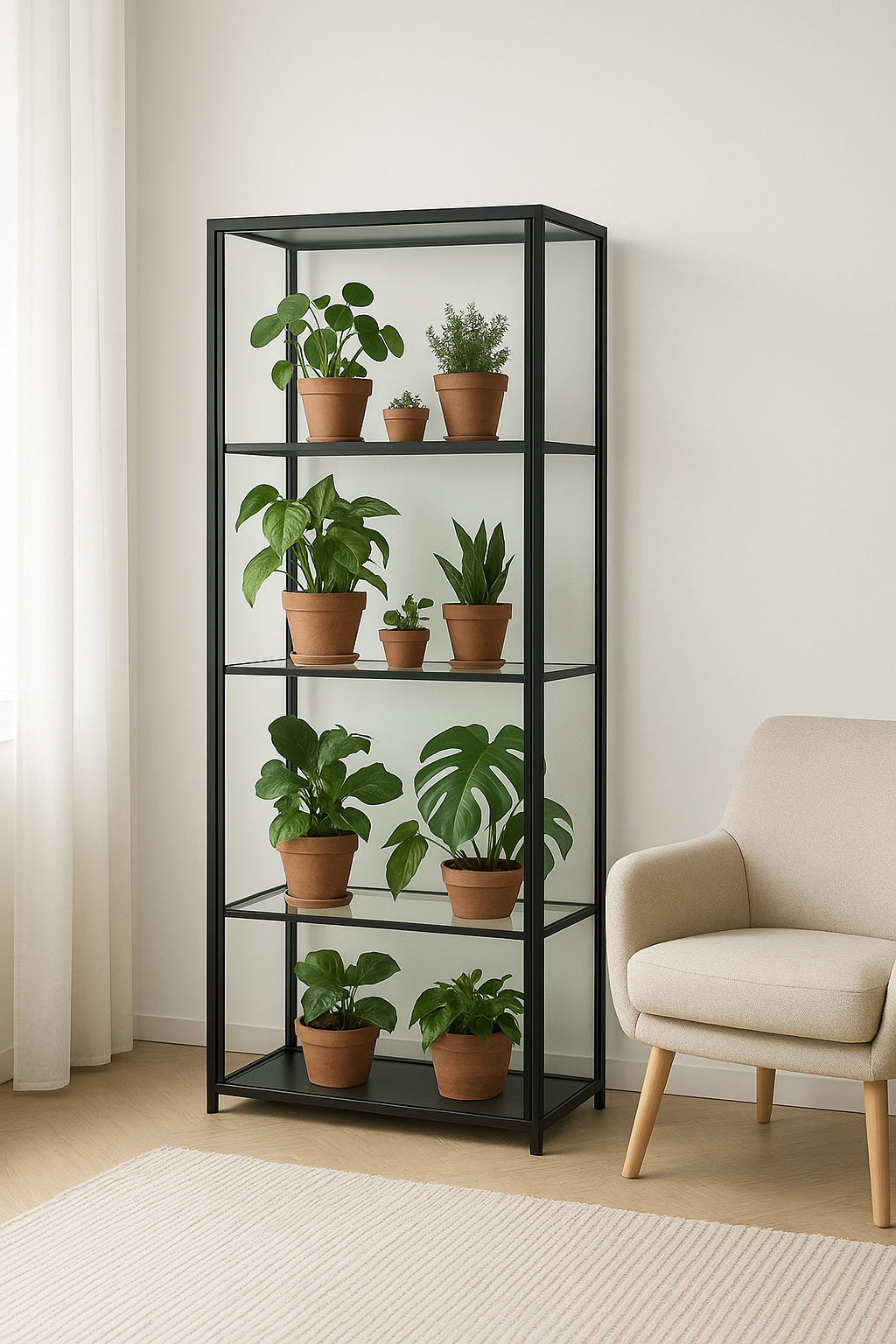
Essential Elements of a Successful Indoor Greenhouse
To make your indoor greenhouse thrive, focus on these essentials:
• Lighting: Natural light is best, but if your space lacks sunlight, invest in LED grow lights.
• Temperature & Humidity: Keep your greenhouse in a stable environment. Tropical plants thrive with added humidity from a humidifier or pebble tray.
• Ventilation: Ensure air circulation with a small fan or open cabinet doors occasionally.
• Watering System: Overwatering is a common mistake. Use pots with drainage holes and water only when needed.
• Plant Variety: Mix easy-to-grow plants like pothos, herbs, or succulents with statement plants like fiddle leaf figs or monsteras.
Decorating Ideas for an Indoor Greenhouse
An indoor greenhouse is more than just plant storage—it’s a design statement. Here are some decor ideas:
• Add String Lights: Warm lighting makes your greenhouse feel magical at night.
• Incorporate Seating: Place a cozy chair near your greenhouse for a relaxing plant-viewing nook.
• Use Decorative Pots: Terracotta, ceramic, or woven planters can elevate your setup.
• Layer Heights: Mix tall plants, hanging vines, and tabletop greenery for visual interest.
• Style with Accessories: Add books, candles, or decorative trays to make it blend with your home style.
Best Plants for Indoor Greenhouses
Some plants thrive better indoors than others. Here are top picks:
• Herbs: Basil, mint, parsley, oregano.
• Leafy Greens: Lettuce, spinach, kale.
• Tropical Plants: Monstera, philodendron, calathea.
• Succulents & Cacti: Easy maintenance and stylish.
• Air-Purifying Plants: Snake plant, peace lily, pothos.
Tips for Maintaining Your Indoor Greenhouse
1. Check plants regularly for pests or diseases.
2. Rotate plants so each one gets equal light.
3. Dust leaves to keep them healthy and photosynthesizing properly.
4. Change decor seasonally to keep your greenhouse looking fresh.
5. Keep it personal—make it your sanctuary, not just a plant shelf.
Final Thoughts
A greenhouse set up inside your home is more than just a gardening project—it’s a lifestyle upgrade. It allows you to bring nature indoors, create a calming atmosphere, and enjoy the therapeutic benefits of greenery. Whether you go minimalist with a sleek cabinet, rustic with a DIY setup, or cozy with a bohemian twist, your indoor greenhouse can reflect your style while giving your plants a happy home.
So, start small, experiment with different designs, and soon your indoor greenhouse will become the most loved corner of your home.
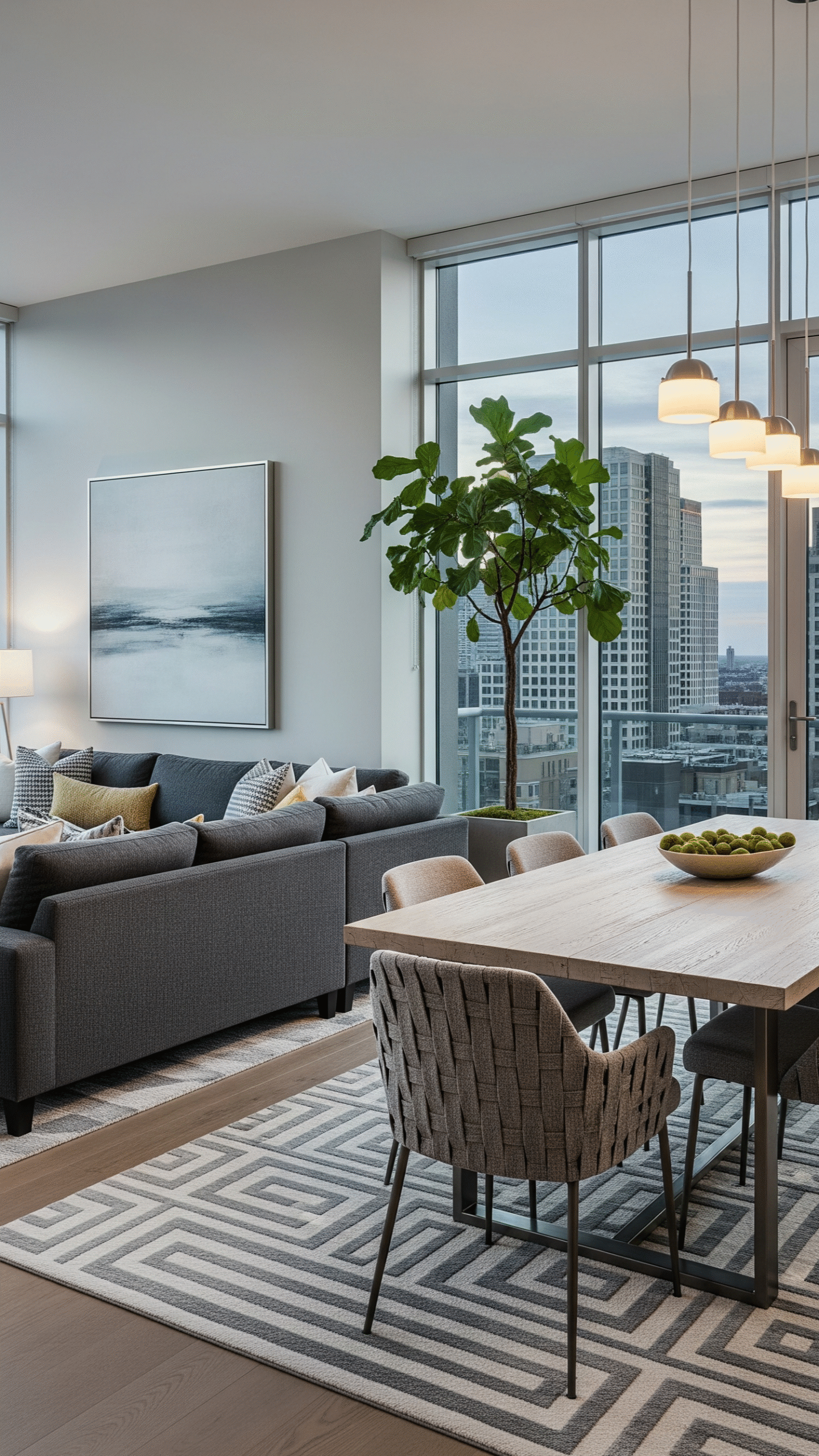
Living Room Dining Room Combo Ideas to Maximize Your Space
When you live in a home with limited square footage, combining areas is often the smartest way to make the most of what you have. One of the most popular and practical solutions is creating a living room dining room combo. This design approach not only saves space but also enhances flow, encourages connection, and gives your home a cohesive look. Whether you live in a compact apartment, a townhouse, or even a larger home, this layout can be both functional and stylish when planned thoughtfully.
In this article, we’ll explore practical tips and design inspiration to help you create a living room dining room combo that feels spacious, comfortable, and beautiful.
1. Define Spaces with Rugs and Furniture Placement
When two rooms share one area, clear visual boundaries are essential. Rugs are one of the simplest ways to define each zone. A large area rug under the sofa can distinguish the living room, while a smaller rug beneath the dining table marks the eating space. Similarly, thoughtful furniture placement can create a natural separation. For instance, placing the back of a sofa toward the dining area subtly divides the two sections without closing off the space.
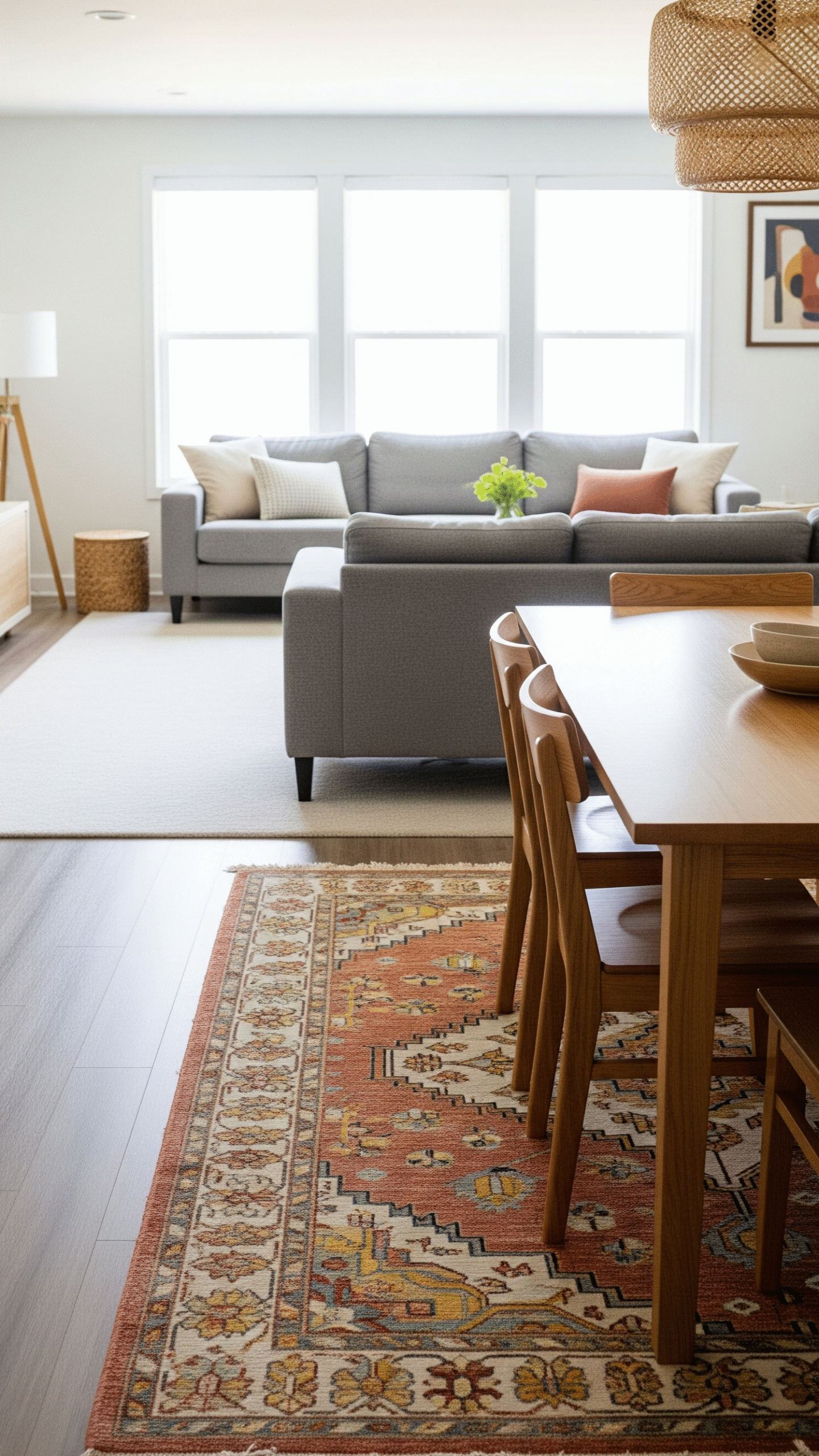
2. Choose a Cohesive Color Palette
The key to a seamless living room dining room combo is unity. Select a consistent color palette for walls, furniture, and decor that ties both spaces together. Neutral tones such as white, beige, and gray work beautifully to create an open, airy atmosphere. You can then add pops of color with throw pillows, dining chairs, or wall art. For a bold statement, consider an accent wall that visually connects the two areas.
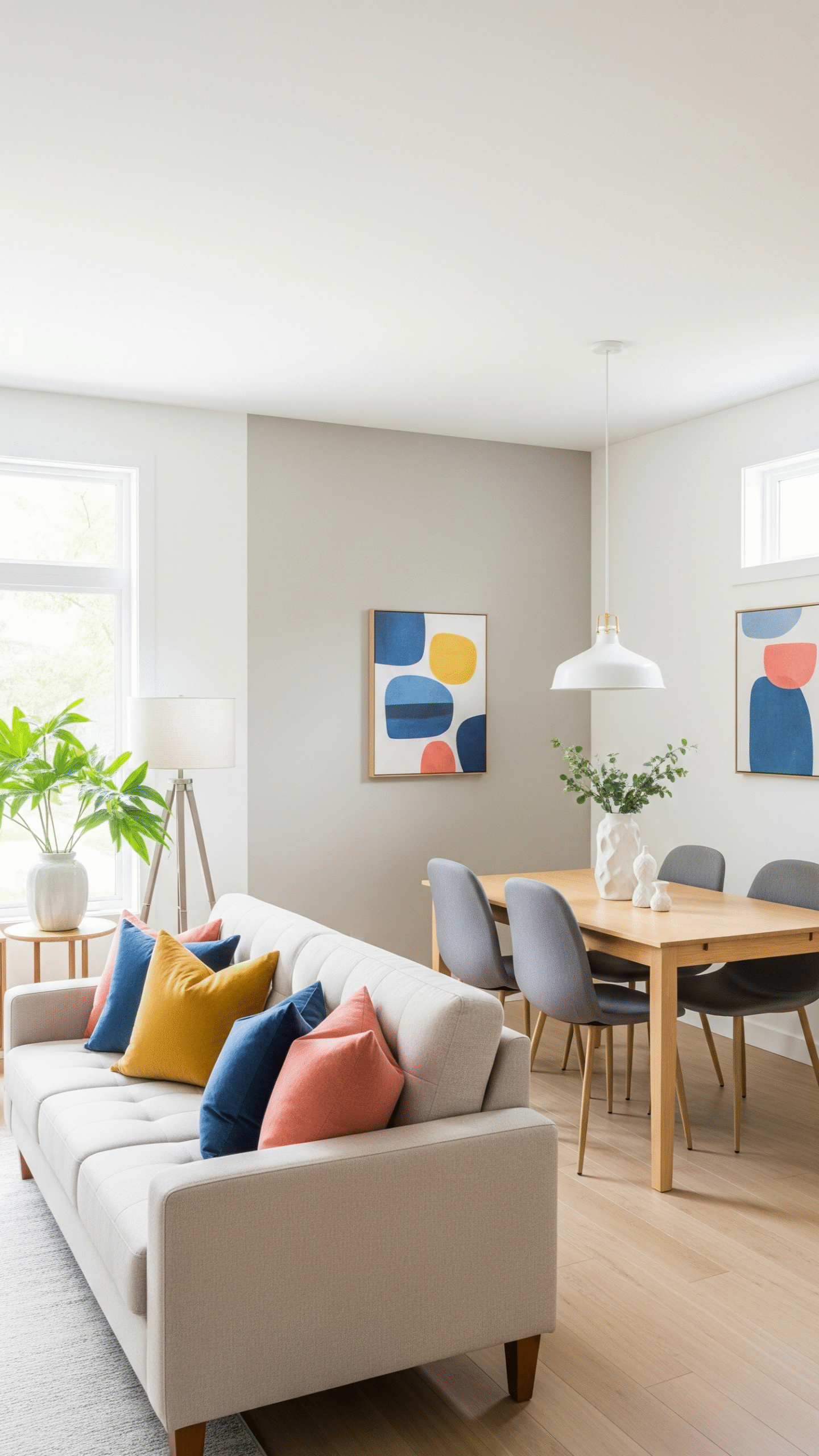
3. Use Multi-Functional Furniture
In small spaces, multi-functional furniture is your best friend. A dining table that doubles as a work desk or a sofa with hidden storage can make your combo space more efficient. Extendable dining tables are another great option, allowing you to expand for guests but save space when it’s just the family. Similarly, a slim console table can serve as a room divider, a buffet, and even a home office desk when needed.
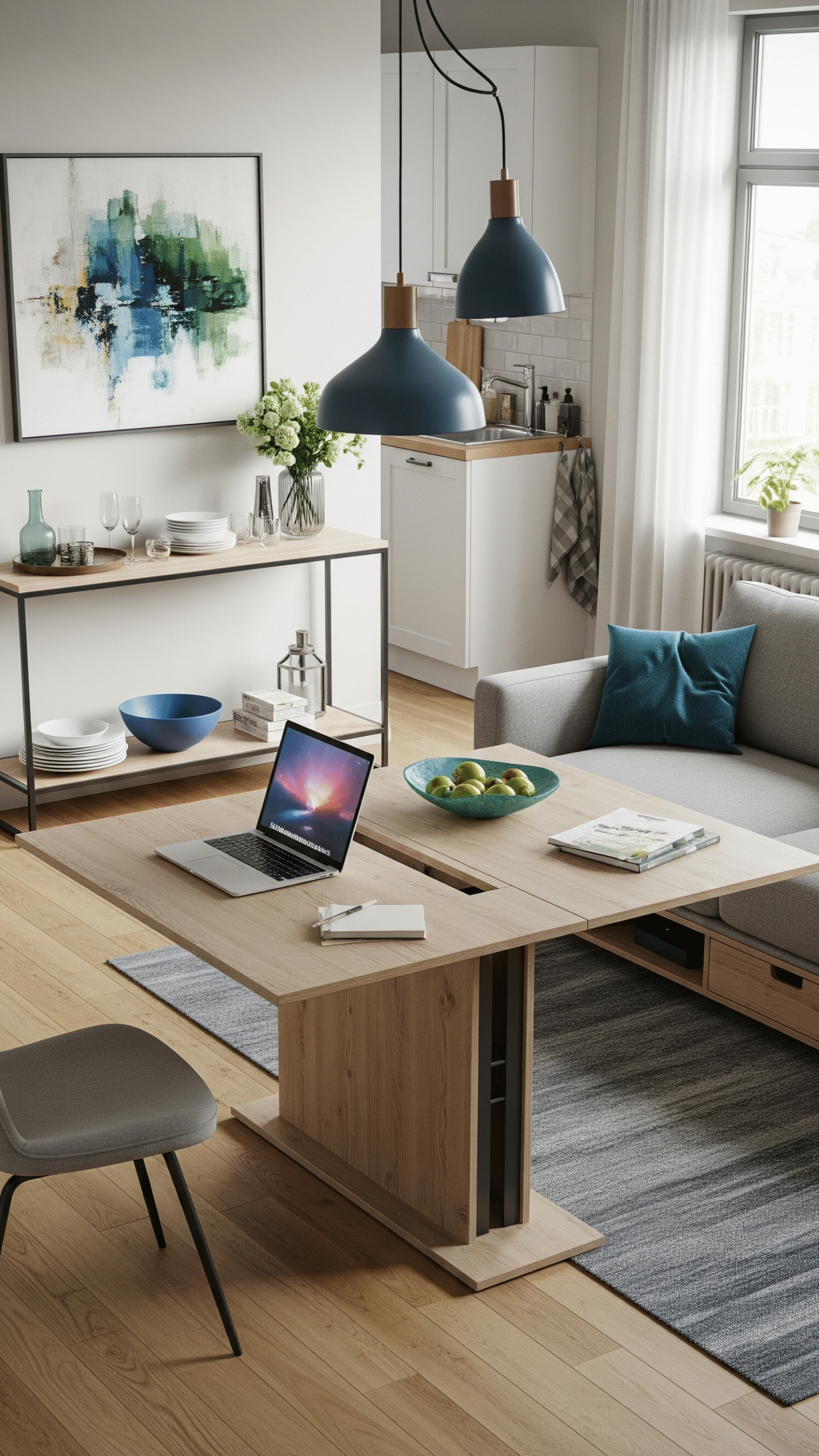
4. Incorporate Lighting for Ambience and Function
Lighting plays a huge role in defining spaces. Use a statement chandelier or pendant above the dining table to anchor that area, and softer ambient lighting such as floor lamps or sconces in the living room. This layered approach not only enhances the atmosphere but also helps create zones within the same open space.
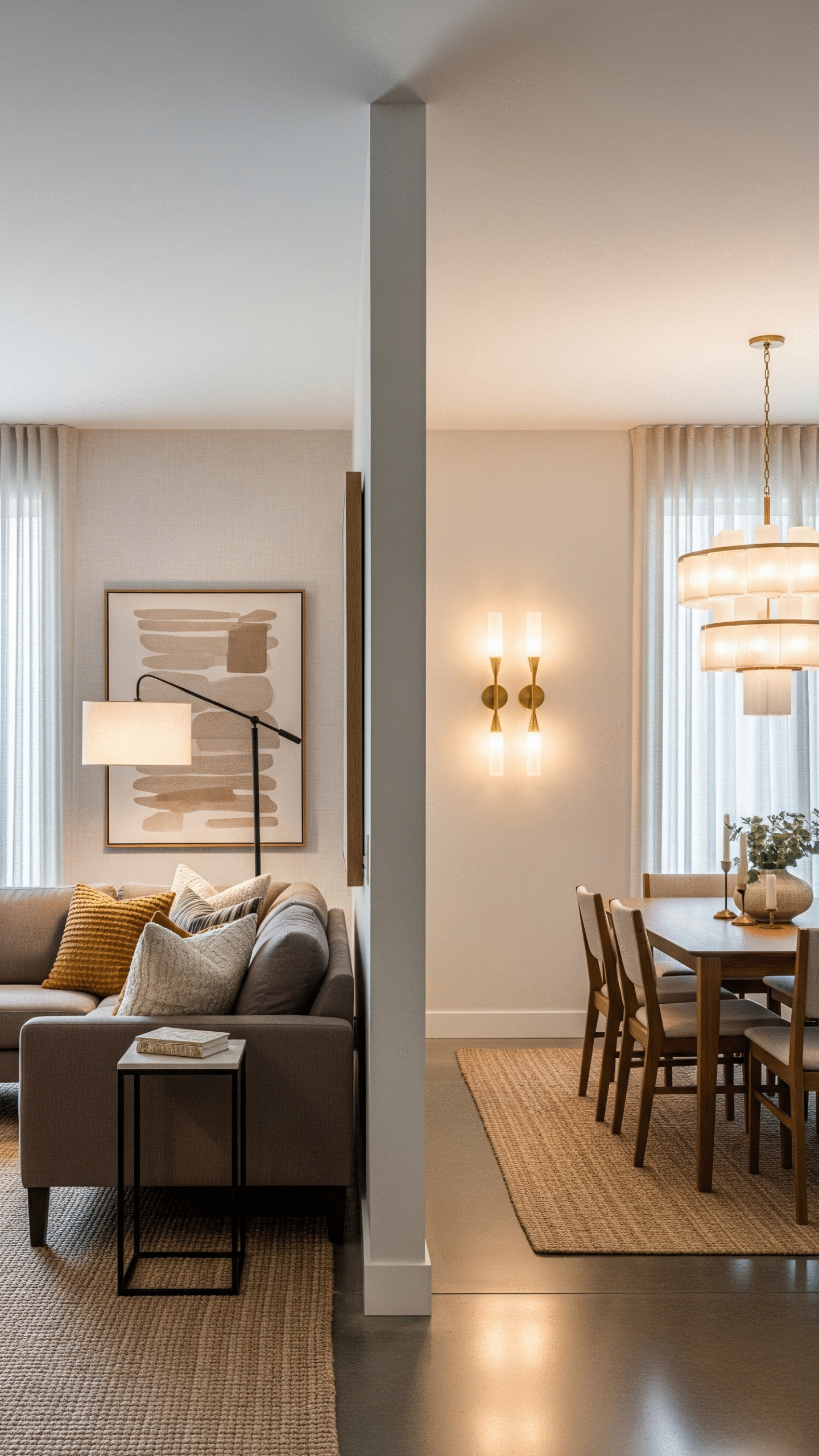
5. Keep the Layout Open and Uncluttered
One of the biggest mistakes in designing a living room dining room combo is overcrowding the area with too much furniture. Opt for streamlined pieces that balance style and function without overwhelming the space. Keep walkways clear, and avoid bulky furniture that blocks the natural flow of movement. Floating shelves, wall-mounted storage, and foldable furniture can keep things light and airy.
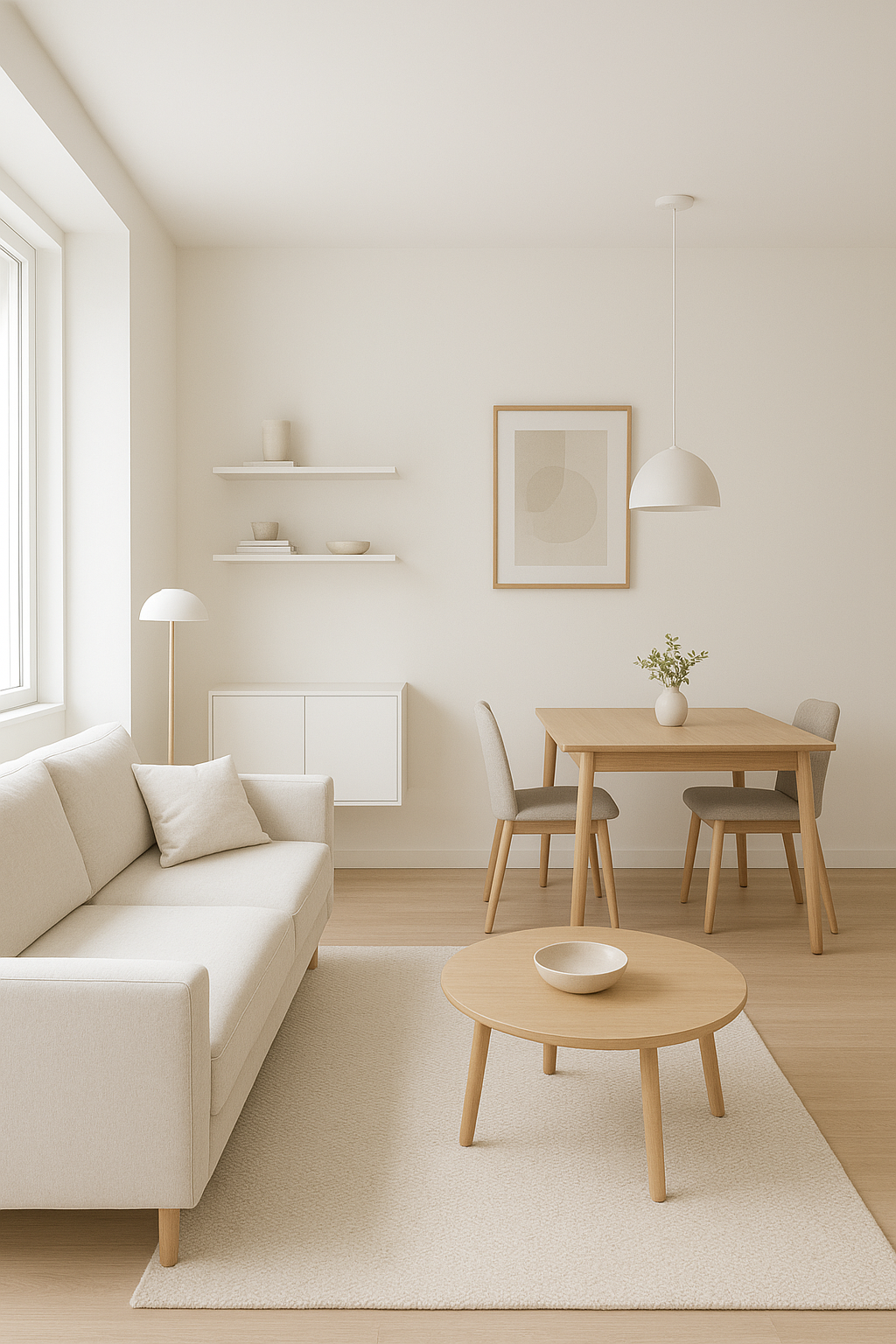
6. Add Personality with Decor
While functionality is key, don’t forget to add personality. Use artwork, mirrors, plants, and textiles to make the space feel warm and inviting. A large mirror can reflect light and make the room feel larger, while greenery adds freshness. Coordinating artwork between the dining and living areas can also visually tie them together.
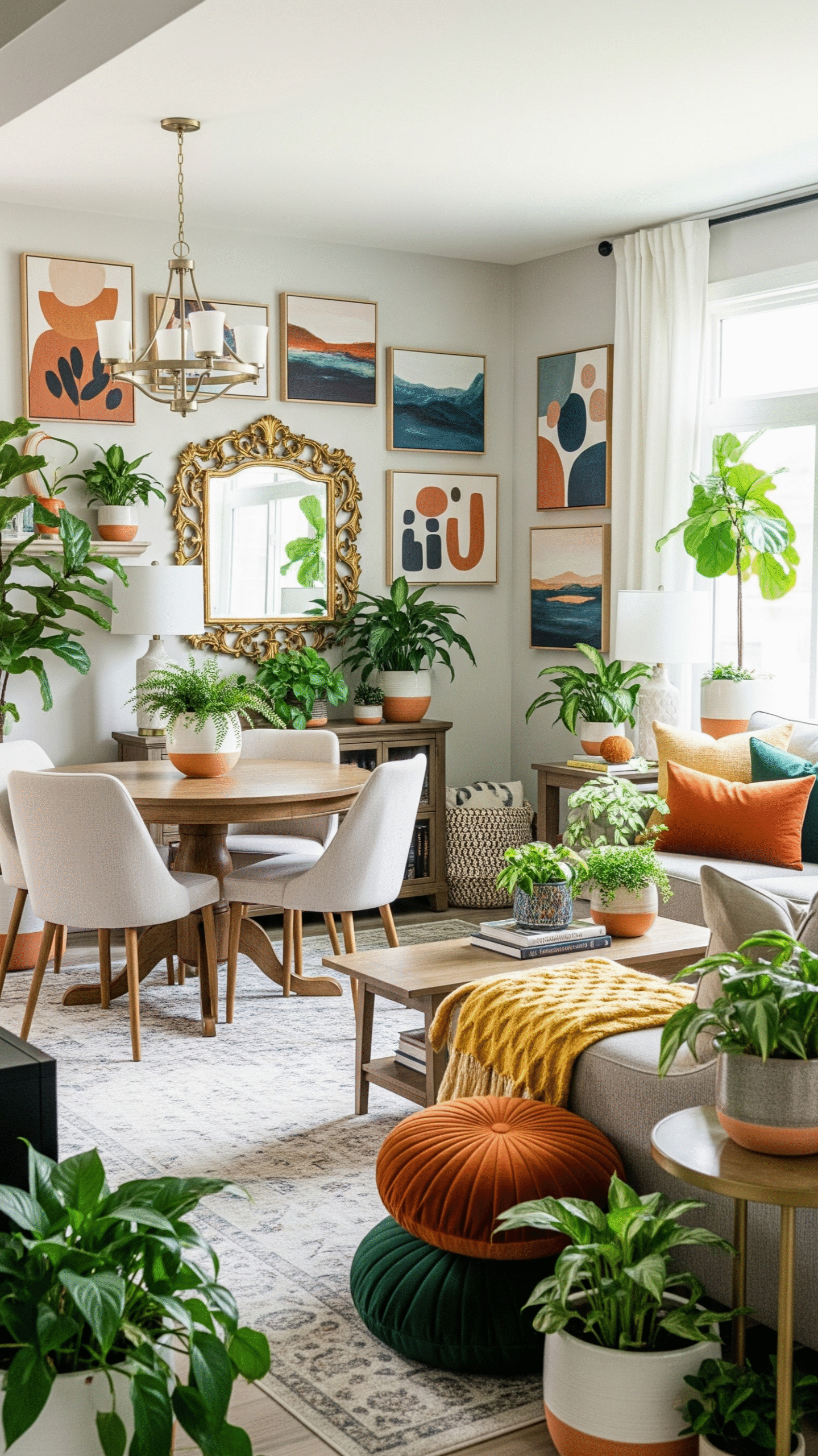
7. Create a Focal Point
Every space benefits from a focal point. In a living room dining combo, you might choose a fireplace, a statement wall, or even a bold piece of art as the anchor. From there, design your layout to highlight this feature while keeping both spaces connected.
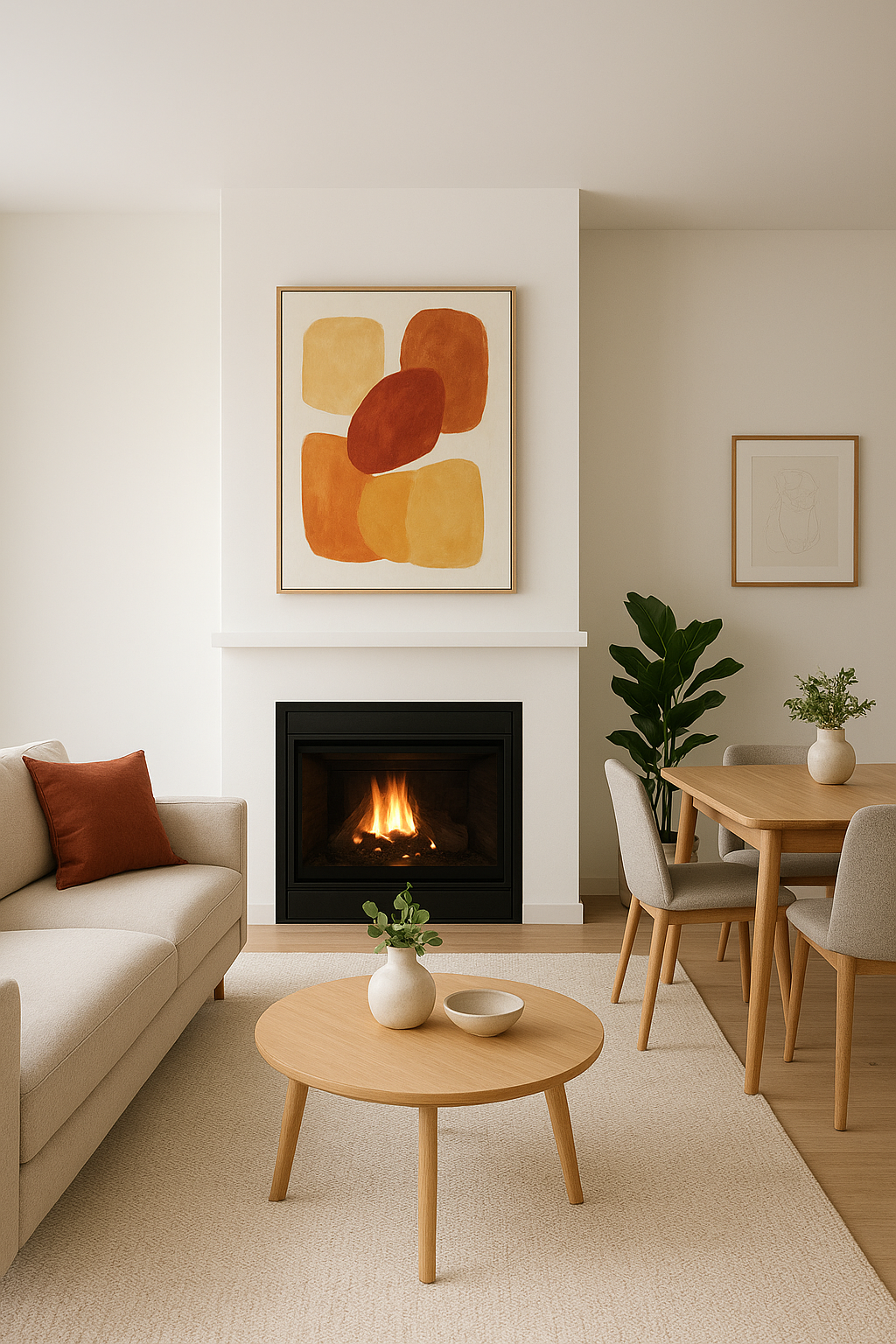
Conclusion
Designing a living room dining room combo is all about balance. By defining zones with rugs, using a cohesive color palette, incorporating multifunctional furniture, and layering lighting, you can create a space that feels harmonious and stylish. With the right choices, even a compact home can offer comfort, beauty, and functionality.
Whether you want a cozy, rustic vibe or a sleek, modern look, these ideas can help you maximize your space while reflecting your personal style. Remember, the best designs are those that make everyday living easier and more enjoyable.
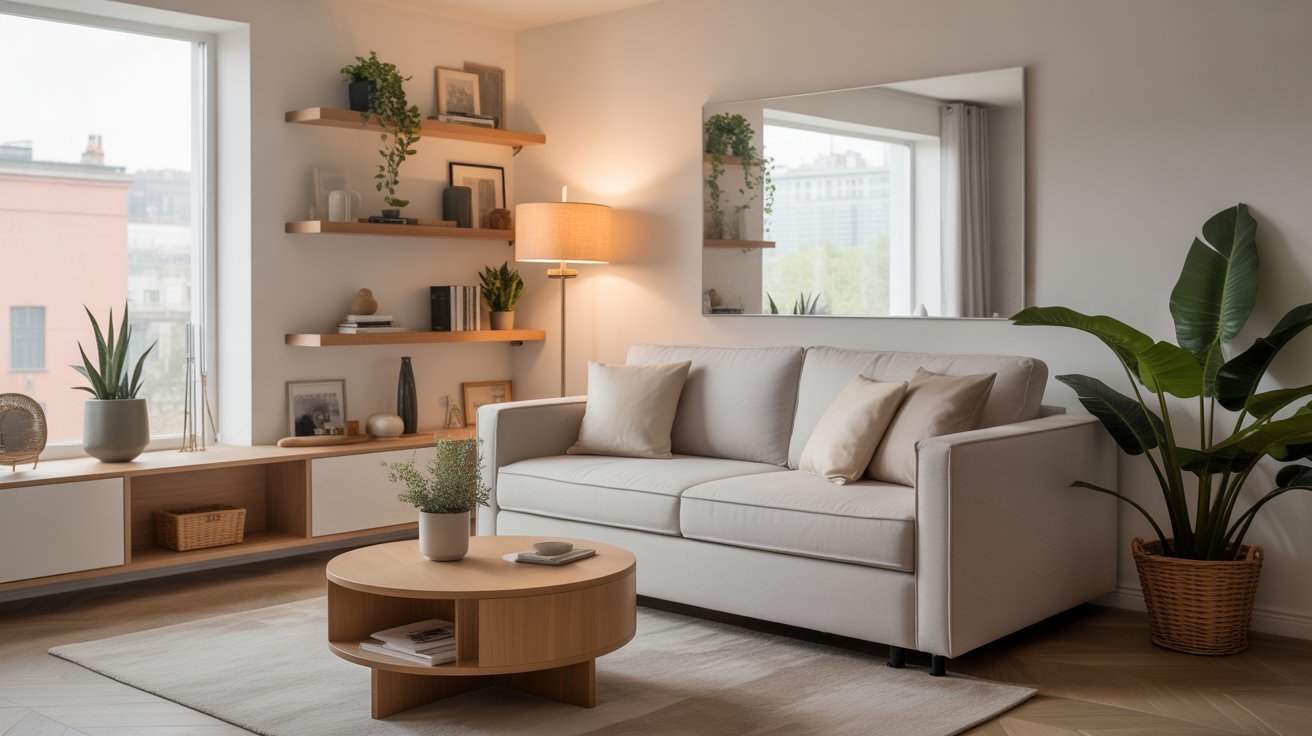
Smart Small Space Living Ideas to Transform Your Home
Living in a compact apartment or tiny house doesn’t mean you have to sacrifice comfort or style. In fact, with the right strategies, you can make the most of every corner and create a home that feels both spacious and inviting. Small space living is all about clever organization, multifunctional furniture, and thoughtful design choices that maximize functionality without clutter. Whether you’re in a studio, condo, or cozy home, these practical ideas will help you transform your compact space into a beautiful retreat.
1. Choose Multipurpose Furniture
One of the best ways to make small rooms more functional is by choosing multipurpose furniture. Think sofa beds, storage ottomans, nesting coffee tables, and fold-out desks. These pieces allow you to switch between functions easily without taking up extra room. For example, a bed with built-in drawers can double as a dresser, while a foldable dining table can act as a desk during the day.
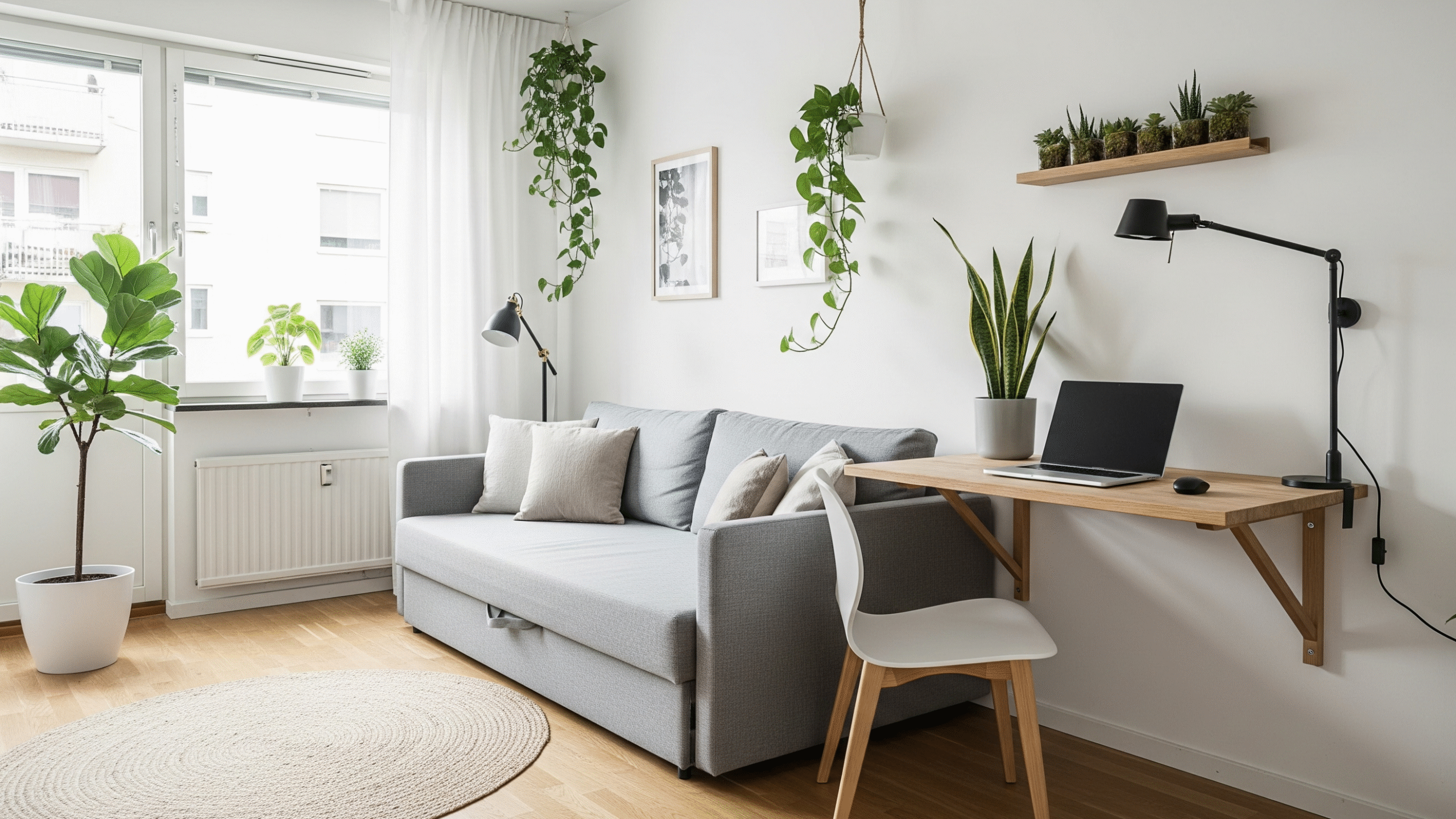
2. Embrace Vertical Storage
When floor space is limited, your walls become your best friend. Vertical storage such as floating shelves, tall bookcases, or wall-mounted cabinets can help you keep clutter at bay while also displaying your favorite décor. Adding hooks and pegboards in the kitchen, entryway, or bedroom is another smart way to save precious floor space while keeping items within reach.
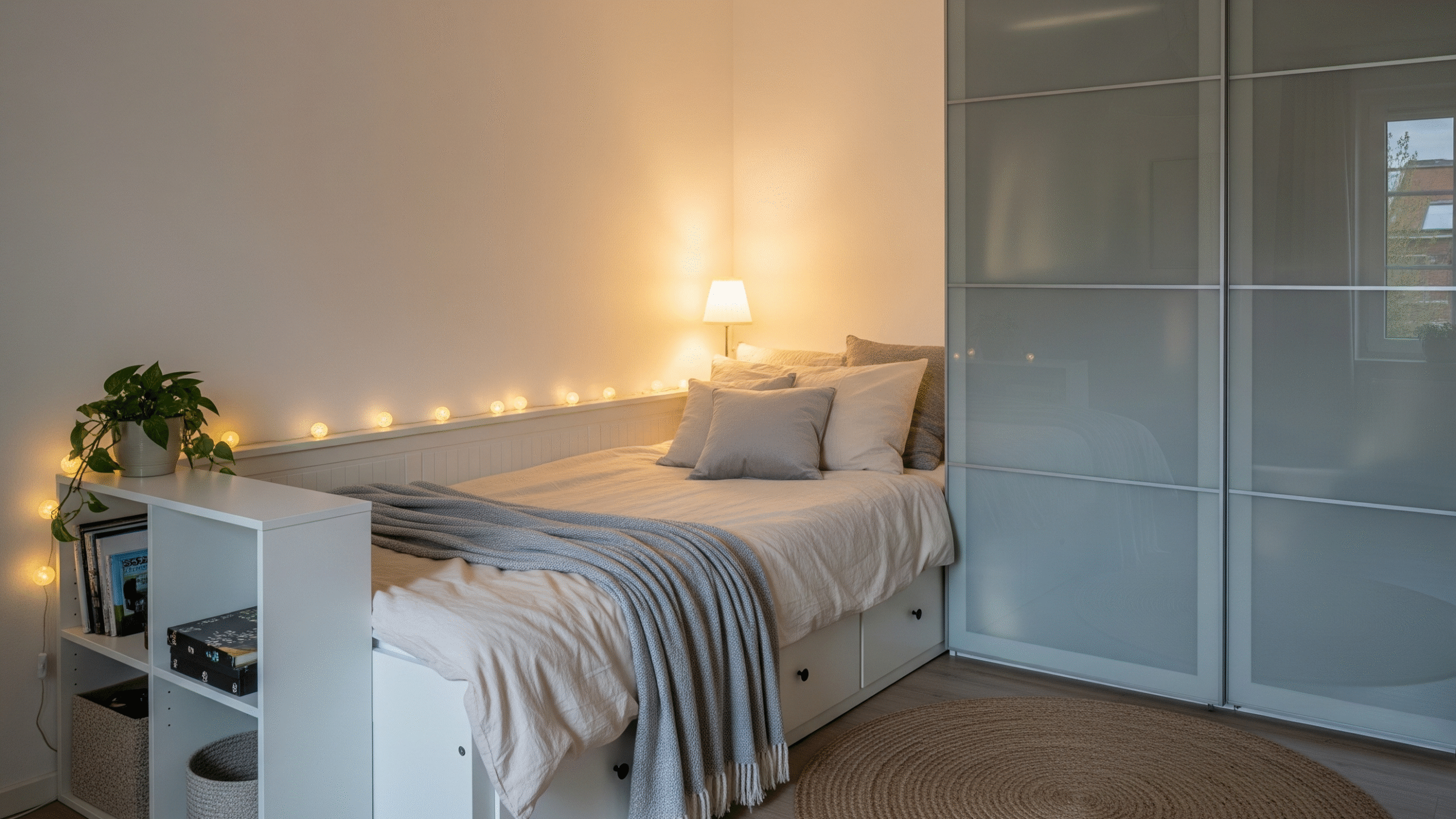
3. Use Light and Mirrors to Create Space
Lighting and mirrors can make a small home feel larger. Large mirrors placed opposite windows reflect natural light and visually double the size of the room. Use light, neutral colors on walls and furniture to make the space feel airy. Incorporating soft, layered lighting with floor lamps, wall sconces, and pendant lights can also add depth and warmth.
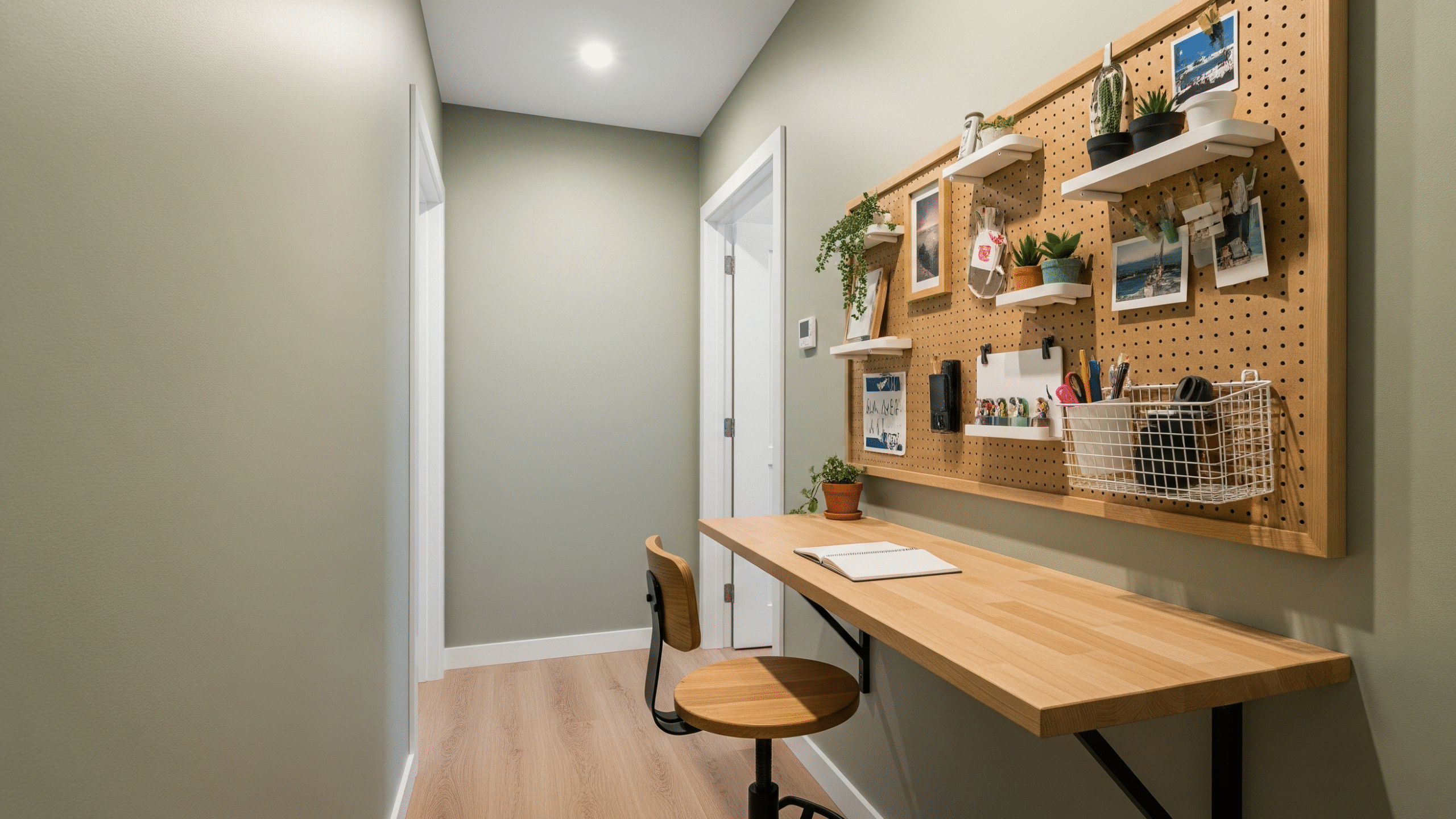
4. Maximize Every Nook and Corner
Small spaces often come with tricky layouts or awkward corners, but these can be transformed into functional zones. Turn a narrow hallway into a mini office with a wall-mounted desk, or use the area under your stairs for storage. Window seats with hidden compartments are another brilliant way to add both seating and storage.
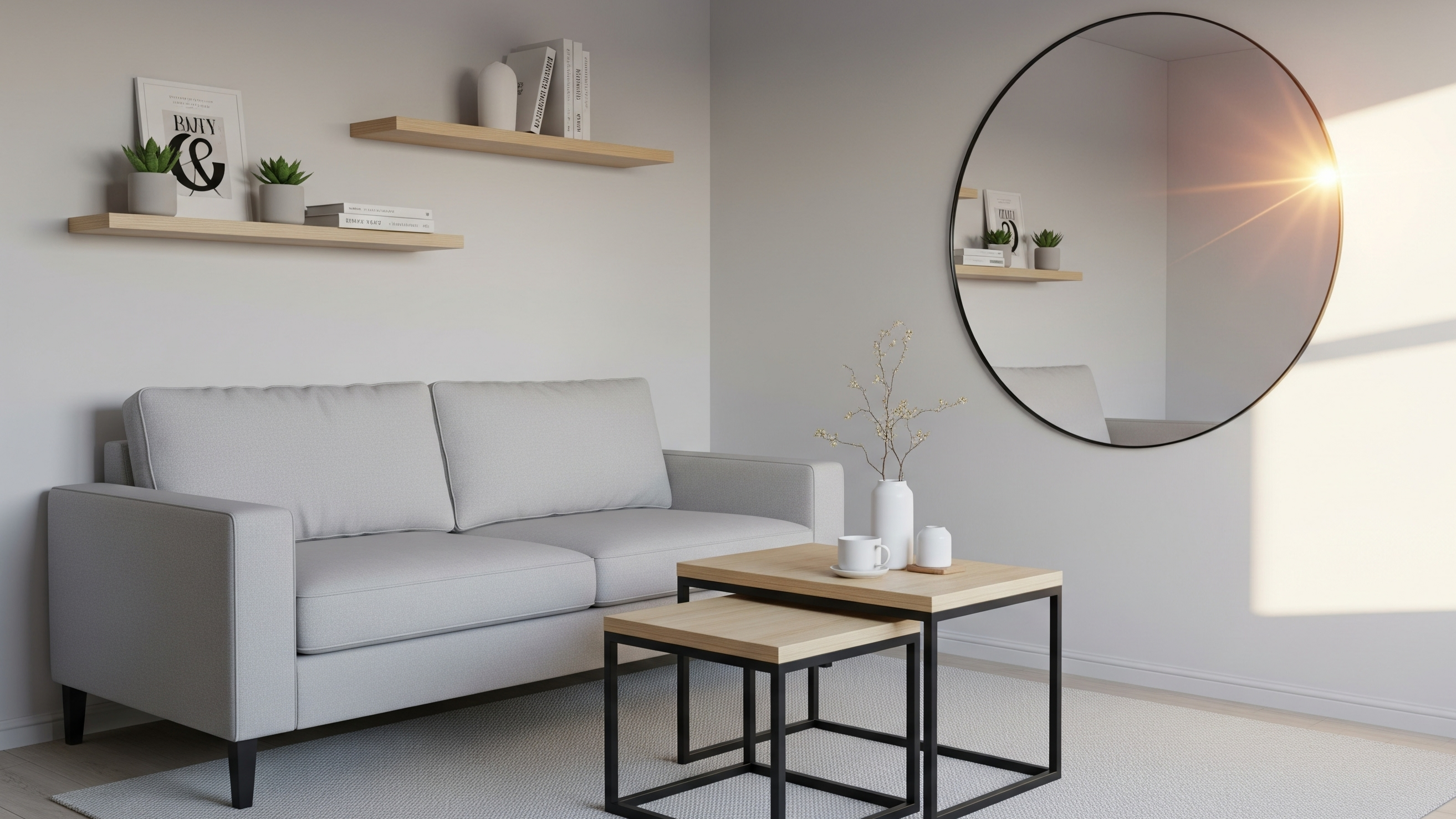
5. Keep Décor Minimal and Functional
Clutter is the enemy of small space living. Instead of filling your home with unnecessary décor, focus on functional accents that also serve a purpose. For example, woven baskets add warmth while doubling as storage, and decorative wall hooks can hold bags, hats, or coats. A “less is more” approach will make your home feel cozy yet uncluttered.

6. Create Defined Zones in Open Layouts
If you’re living in a studio or open-plan home, dividing your space into zones helps maintain order. Use area rugs, bookshelves, or folding screens to separate the living, sleeping, and dining areas. Even small distinctions like placing a tall plant between the sofa and bed can make the space feel more organized and functional.
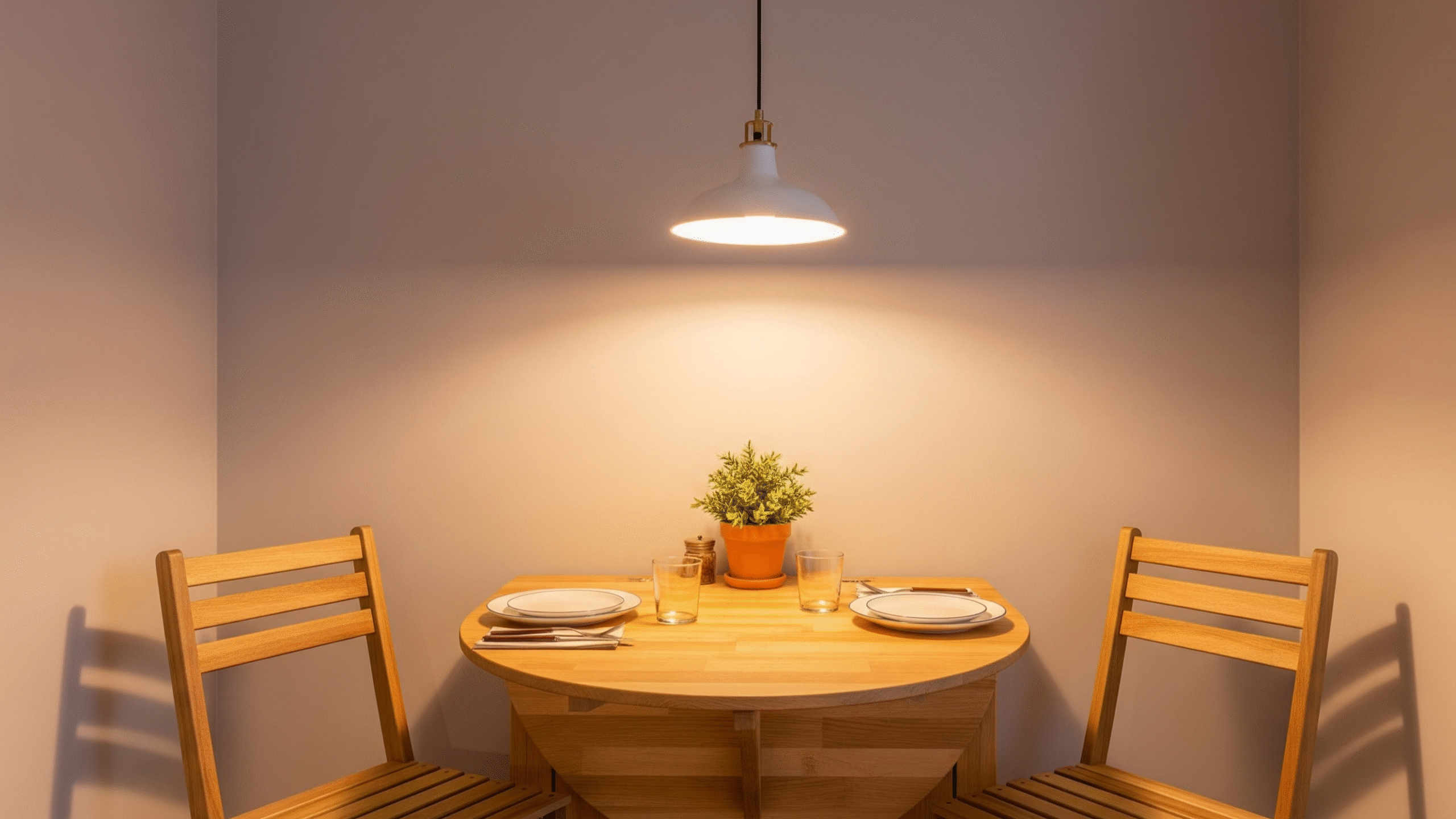
7. Optimize the Kitchen for Efficiency
Small kitchens can be stylish and practical with a few adjustments. Use magnetic strips for knives, add open shelves for frequently used dishes, and install a foldable breakfast bar to save space. Slim appliances designed for compact living can also make a big difference, giving you all the functionality you need without overcrowding the room.
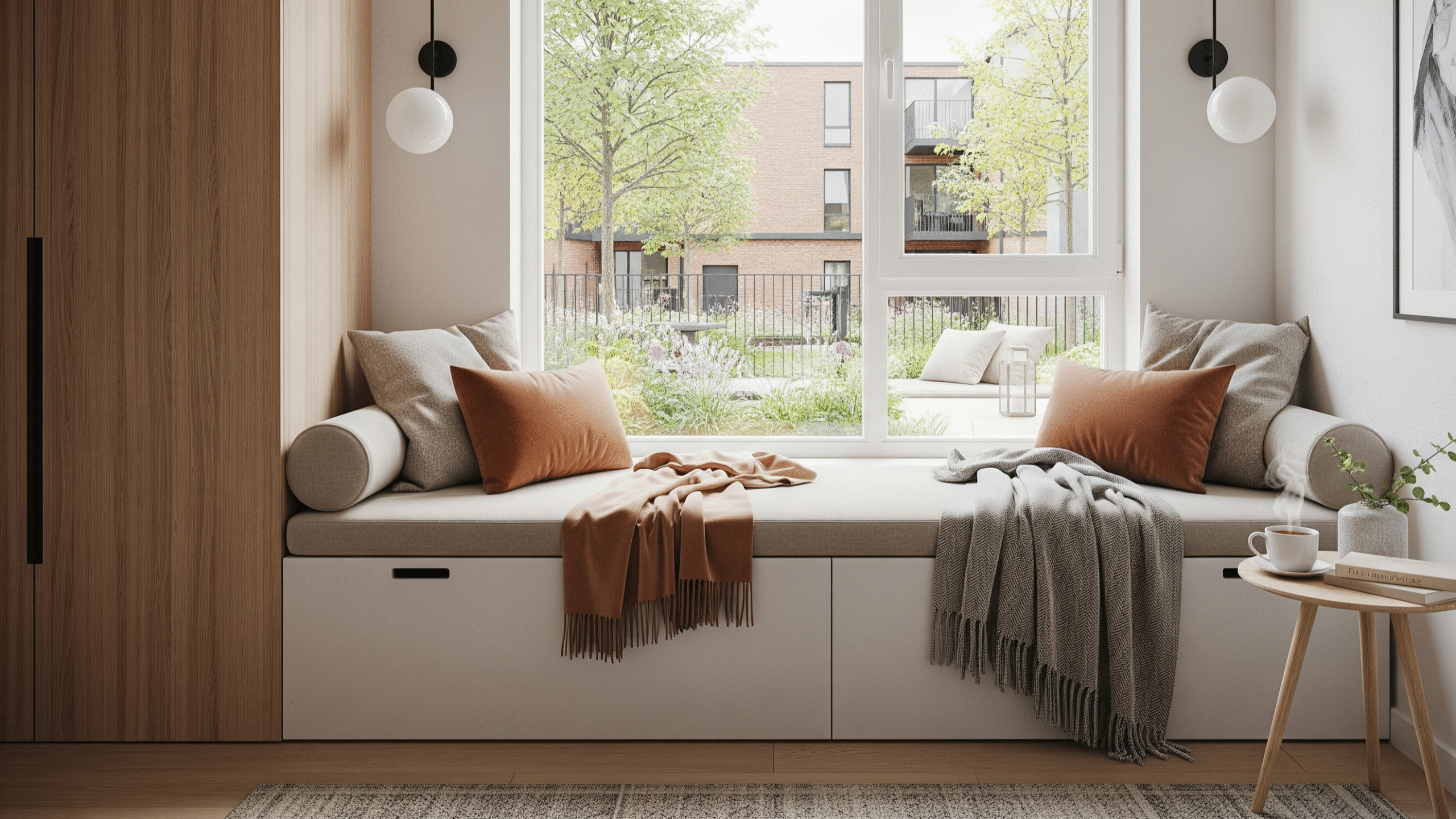
8. Bring the Outdoors In
Plants are a wonderful way to add freshness and life to a small home. Choose hanging planters, wall-mounted pots, or small indoor trees that won’t take up much floor space. Greenery not only improves air quality but also makes compact spaces feel brighter and more welcoming.
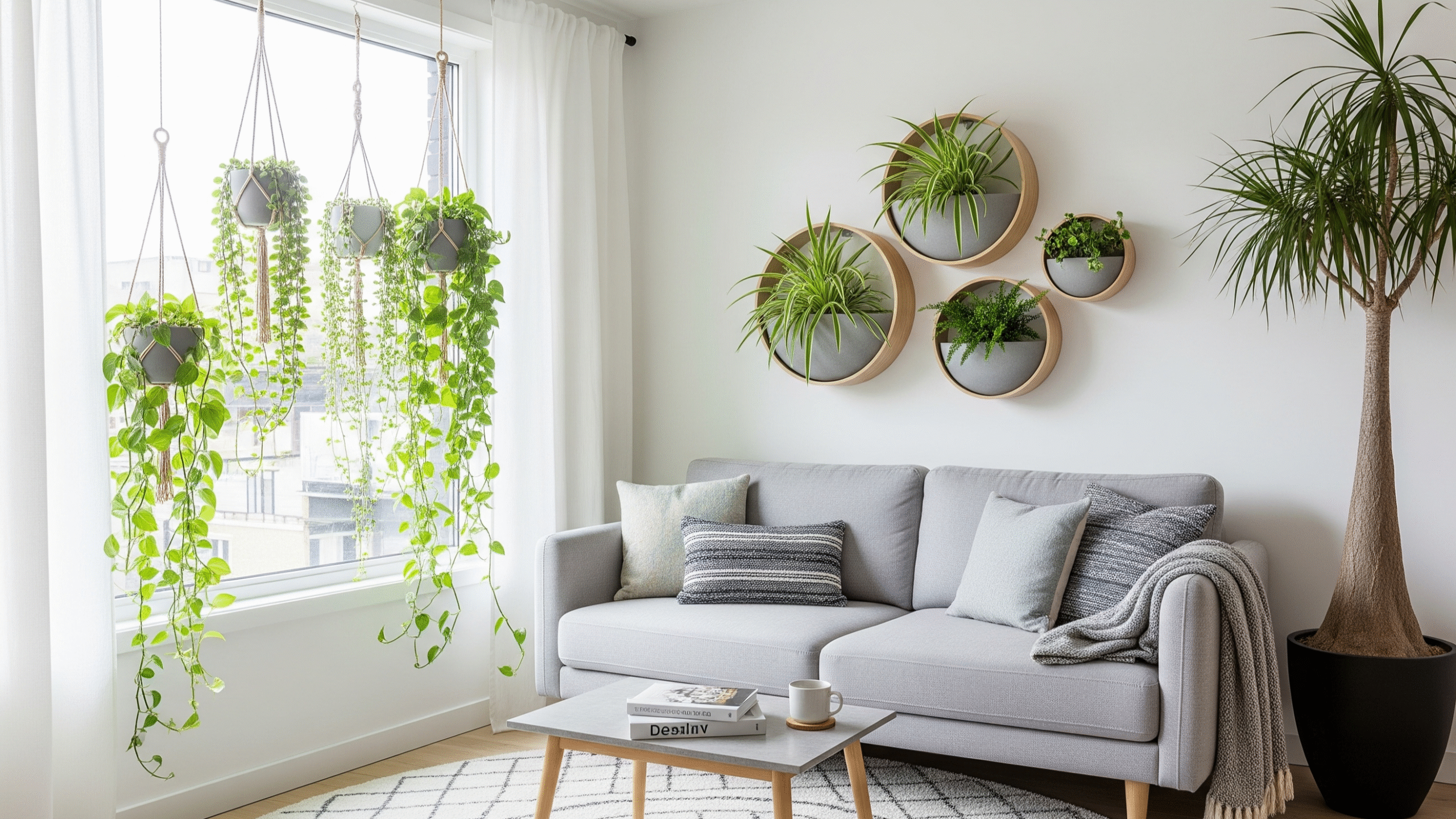
9. Stay Organized with Hidden Storage
The secret to thriving in small space living is staying organized. Hidden storage solutions—like ottomans with lids, beds with drawers, or benches with compartments—help you tuck away clutter while maintaining a clean, stylish look.
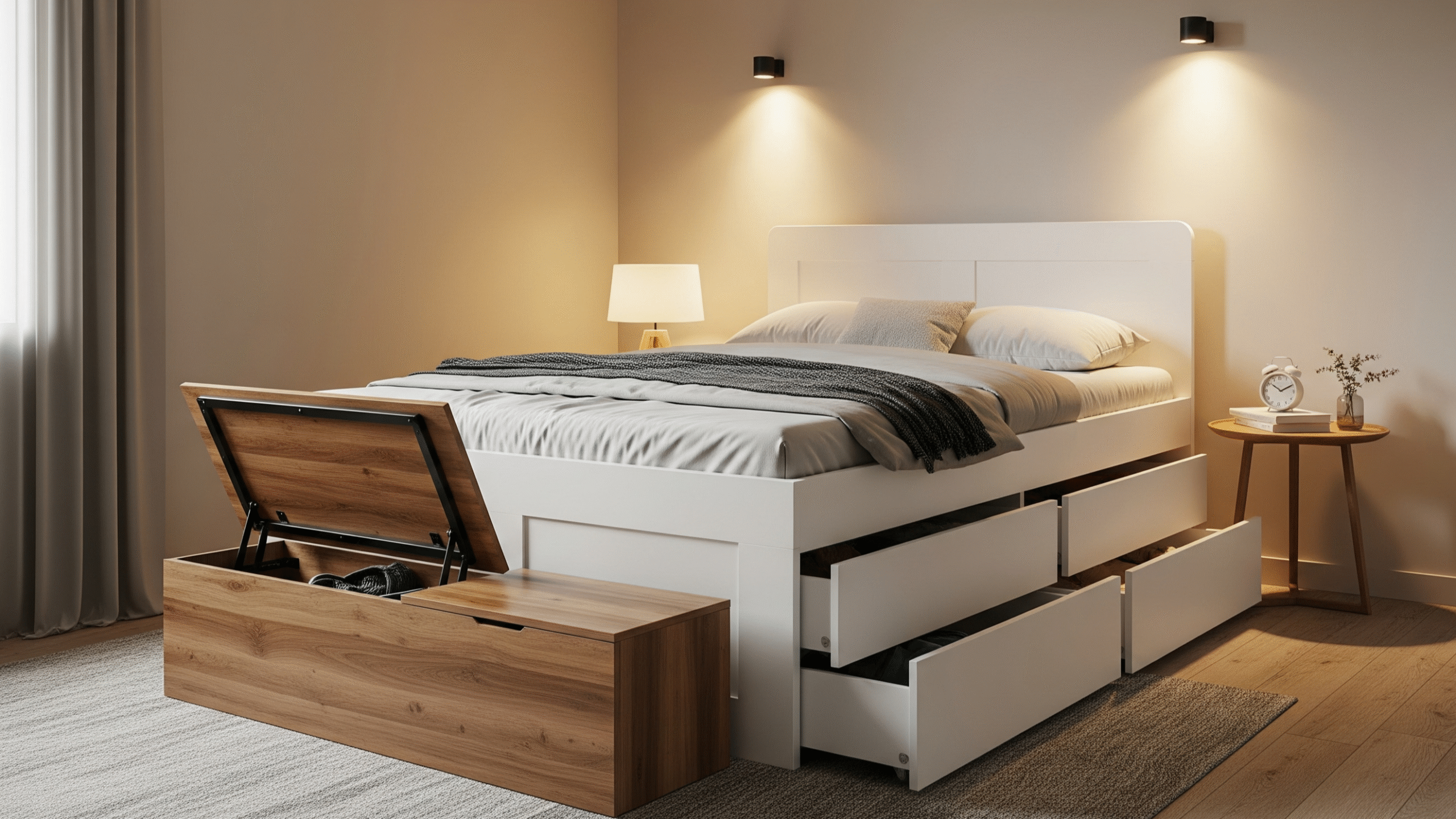
Final Thoughts
With the right strategies, small homes can be just as functional and beautiful as larger ones. By combining smart furniture choices, creative storage, and minimal yet thoughtful décor, you can transform even the tiniest apartment into a cozy and stylish haven. Remember, small space living isn’t about limiting yourself—it’s about living smarter, simpler, and more intentionally.
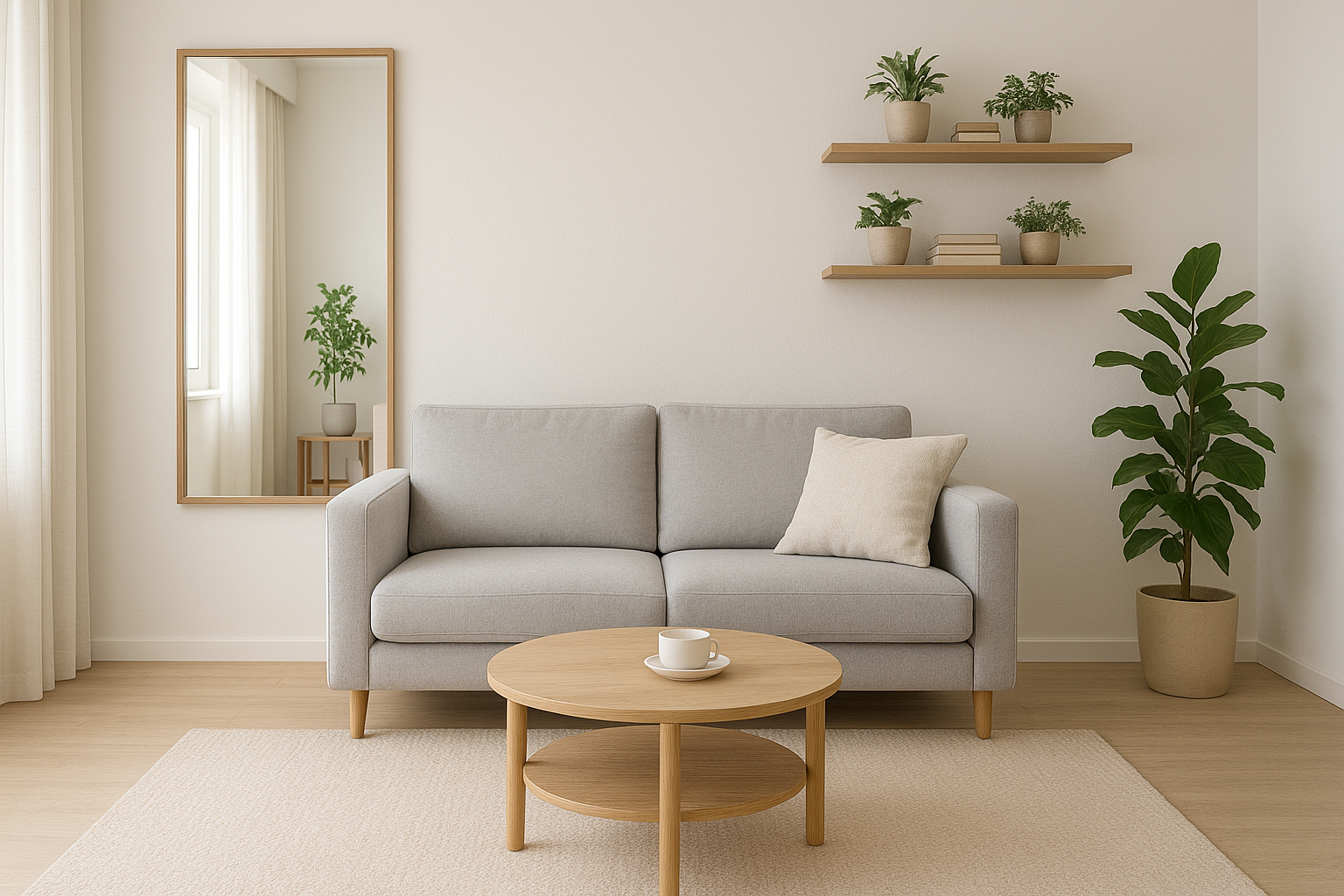
Small Living Room Ideas Apartment – Stylish Tips for Maximizing Your Space
Living in an apartment often means dealing with a smaller living room, but that doesn’t mean you have to sacrifice style, comfort, or functionality. With the right small living room ideas apartment designs, you can make your space feel bigger, brighter, and more inviting without breaking the bank. Whether you’re working with a studio, a one-bedroom, or a shared apartment, these creative tips will help you maximize your living area while keeping it cozy and aesthetically pleasing.
1. Choose Light and Neutral Colors
One of the easiest ways to make a small living room feel more spacious is by choosing a light color palette. Whites, beiges, light grays, and soft pastels reflect natural light, giving the illusion of a bigger room. If you want to add some depth, consider incorporating a few darker accent pieces like navy throw pillows or a charcoal rug. This contrast will make your space feel layered yet uncluttered.
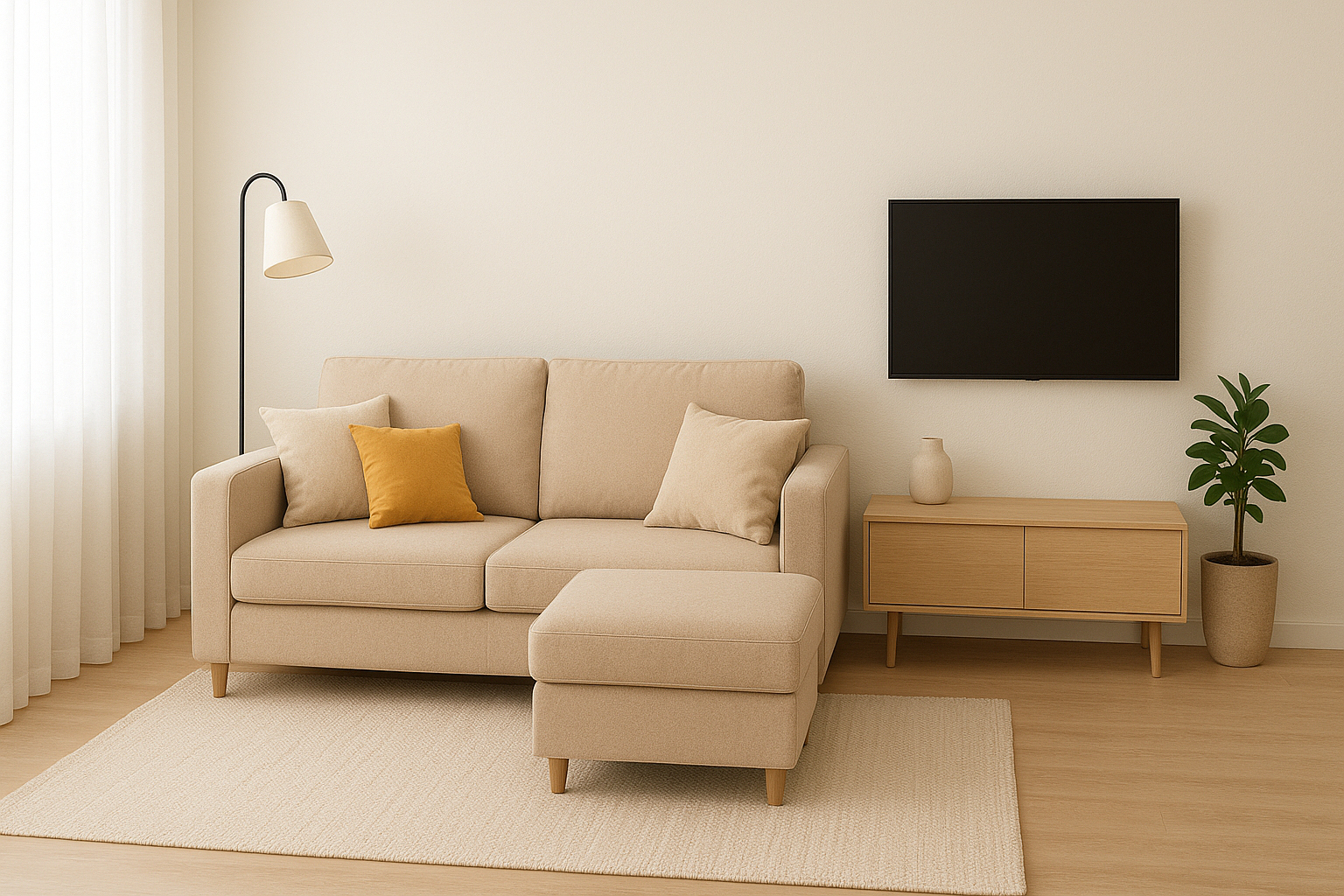
2. Invest in Multifunctional Furniture
In a small apartment, every piece of furniture should work harder for you. Look for multifunctional items like a coffee table with storage, an ottoman that doubles as extra seating, or a sofa bed for guests. Modular furniture is another great choice, as you can reconfigure it based on your needs without crowding your living room.
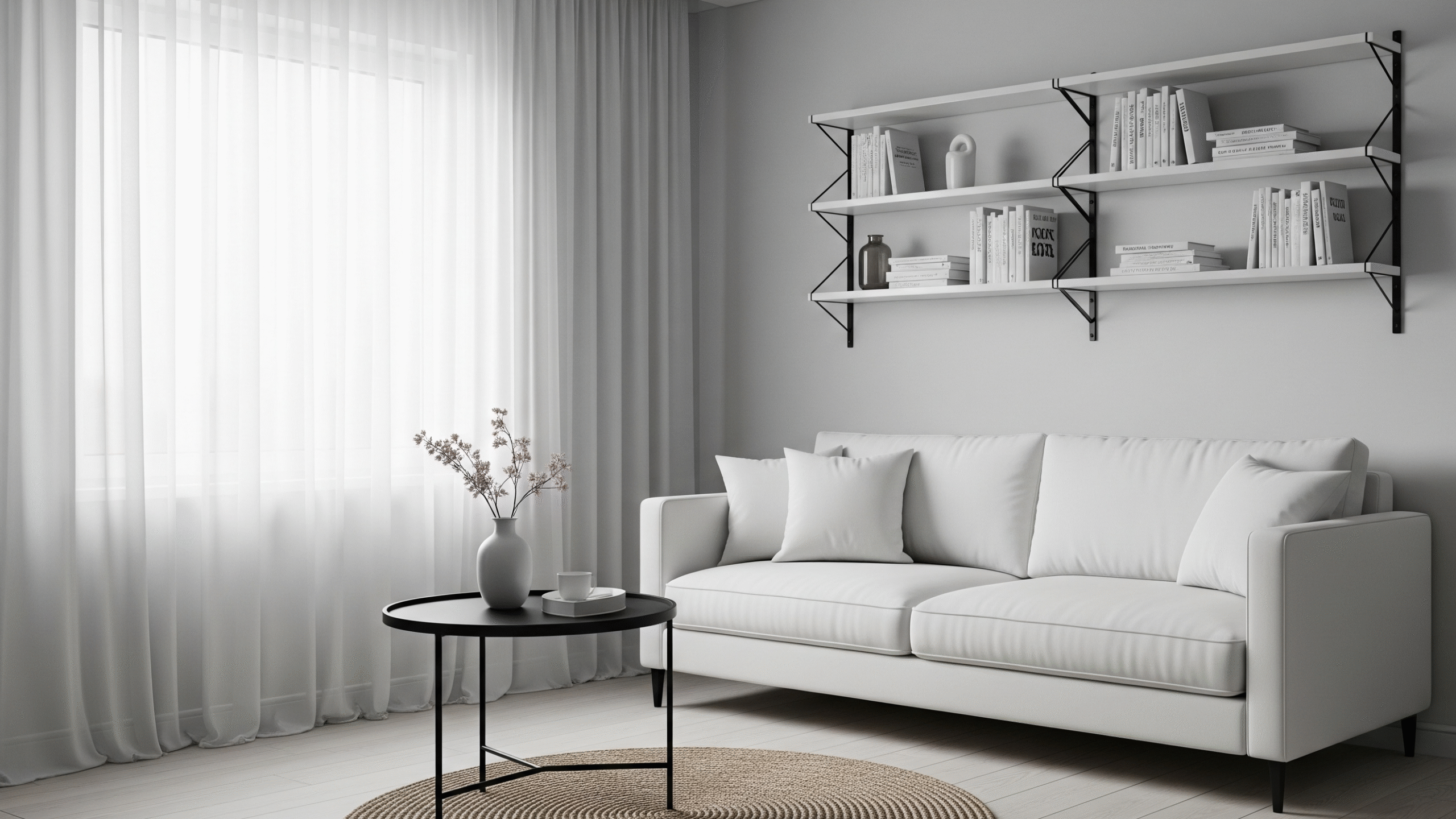
3. Use Vertical Space Wisely
When floor space is limited, think upward. Wall-mounted shelves, tall bookcases, and hanging plants draw the eye upward, making the room appear taller. Floating shelves above a sofa or TV unit can store books, plants, and decorative pieces without taking up valuable square footage.
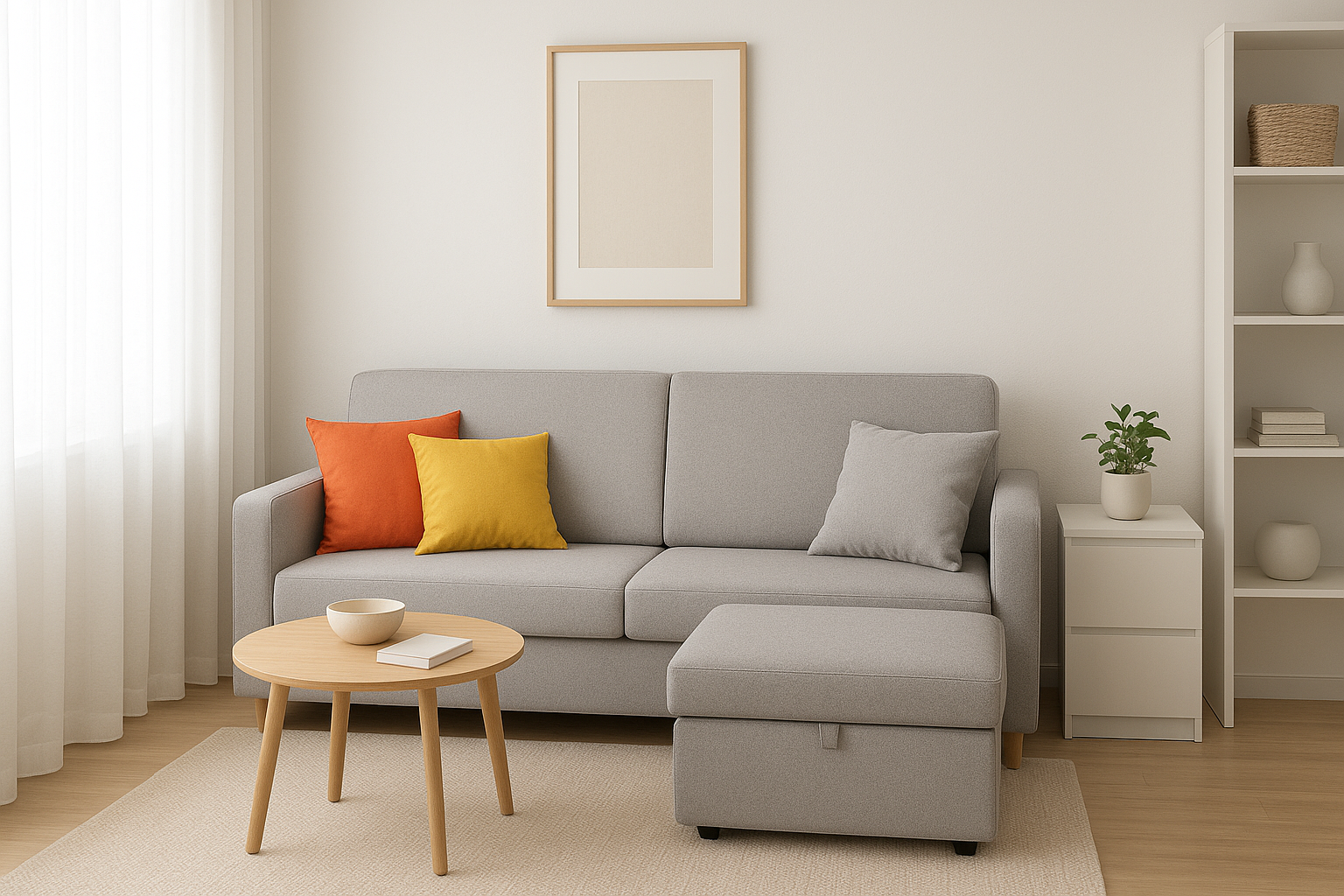
4. Add Mirrors to Create Depth
Mirrors are a tried-and-true trick for small spaces. By reflecting light, they make a room look brighter and more open. A large statement mirror on one wall or a set of smaller decorative mirrors can instantly enhance your apartment’s living room. Position them opposite a window if possible to maximize the light reflection.
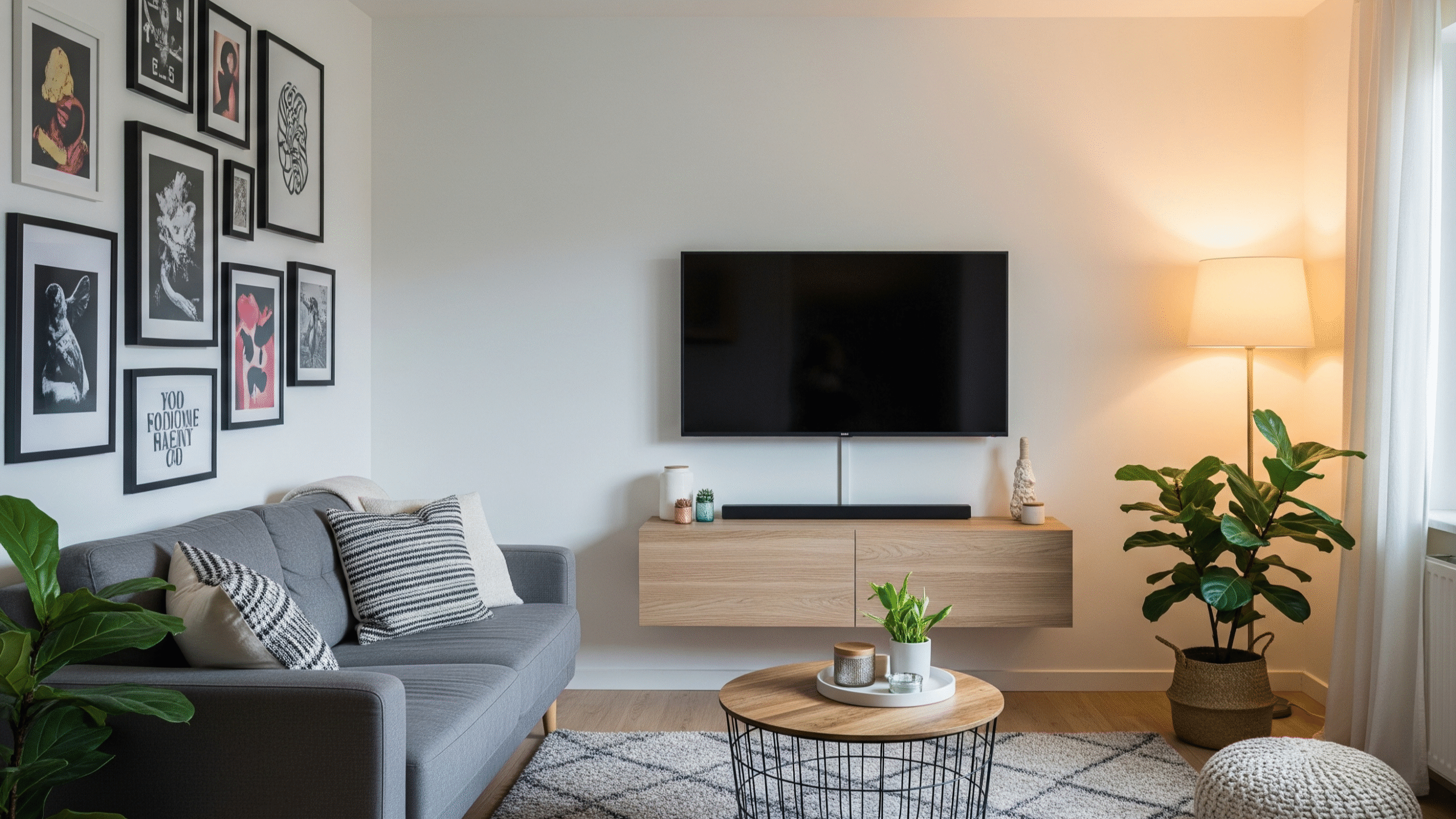
5. Keep the Layout Open
In a small apartment living room, less is more. Avoid blocking pathways with bulky furniture, and leave open areas that allow for easy movement. Consider a floating sofa arrangement or push furniture against the walls to free up central space. Rugs can also help define different zones, making the room feel organized and purposeful.
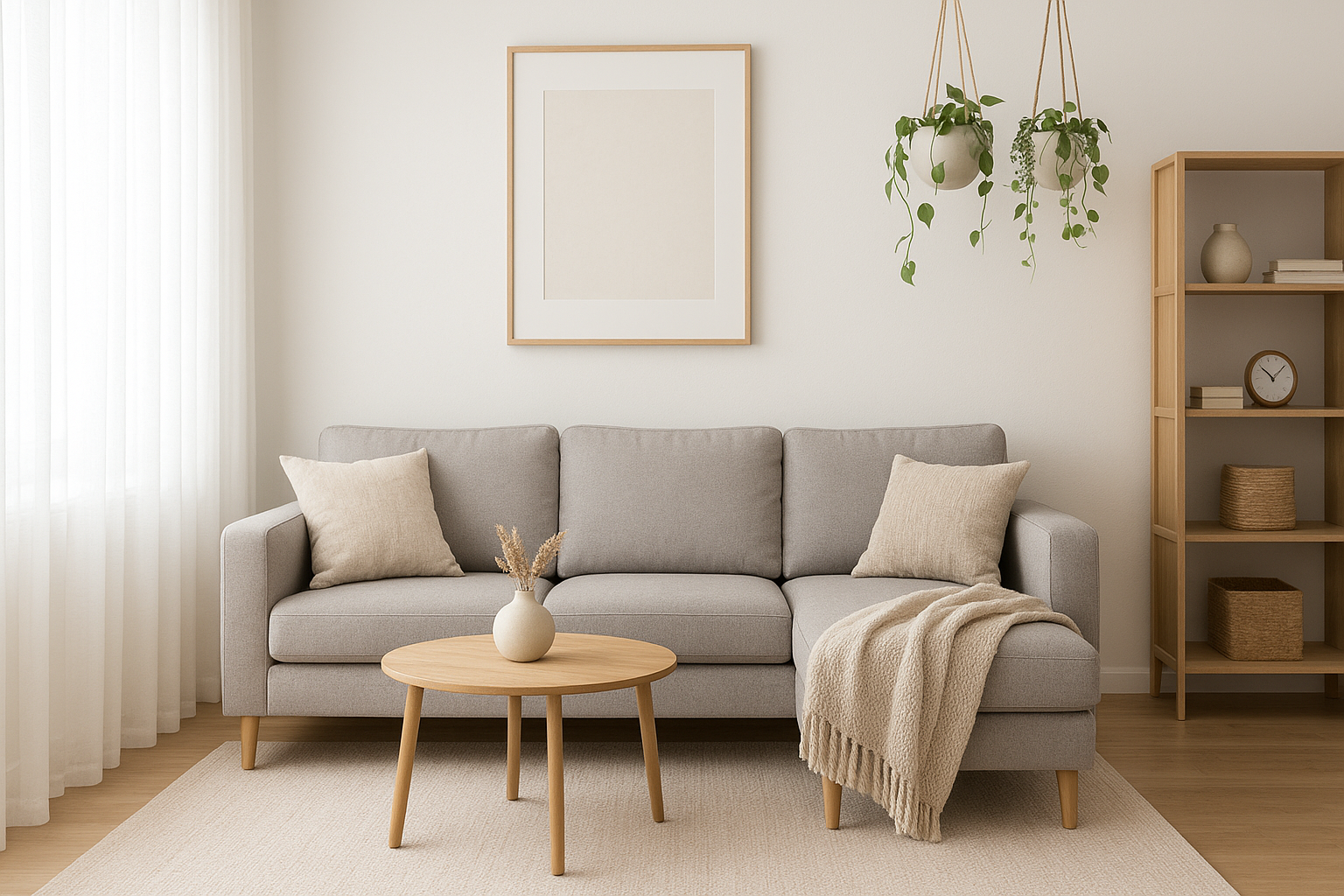
6. Bring in Plants for Freshness
Greenery can transform a small space, making it feel more vibrant and alive. Opt for compact indoor plants like snake plants, pothos, or succulents. Use hanging planters or wall-mounted plant holders to save surface space while adding a refreshing natural touch.
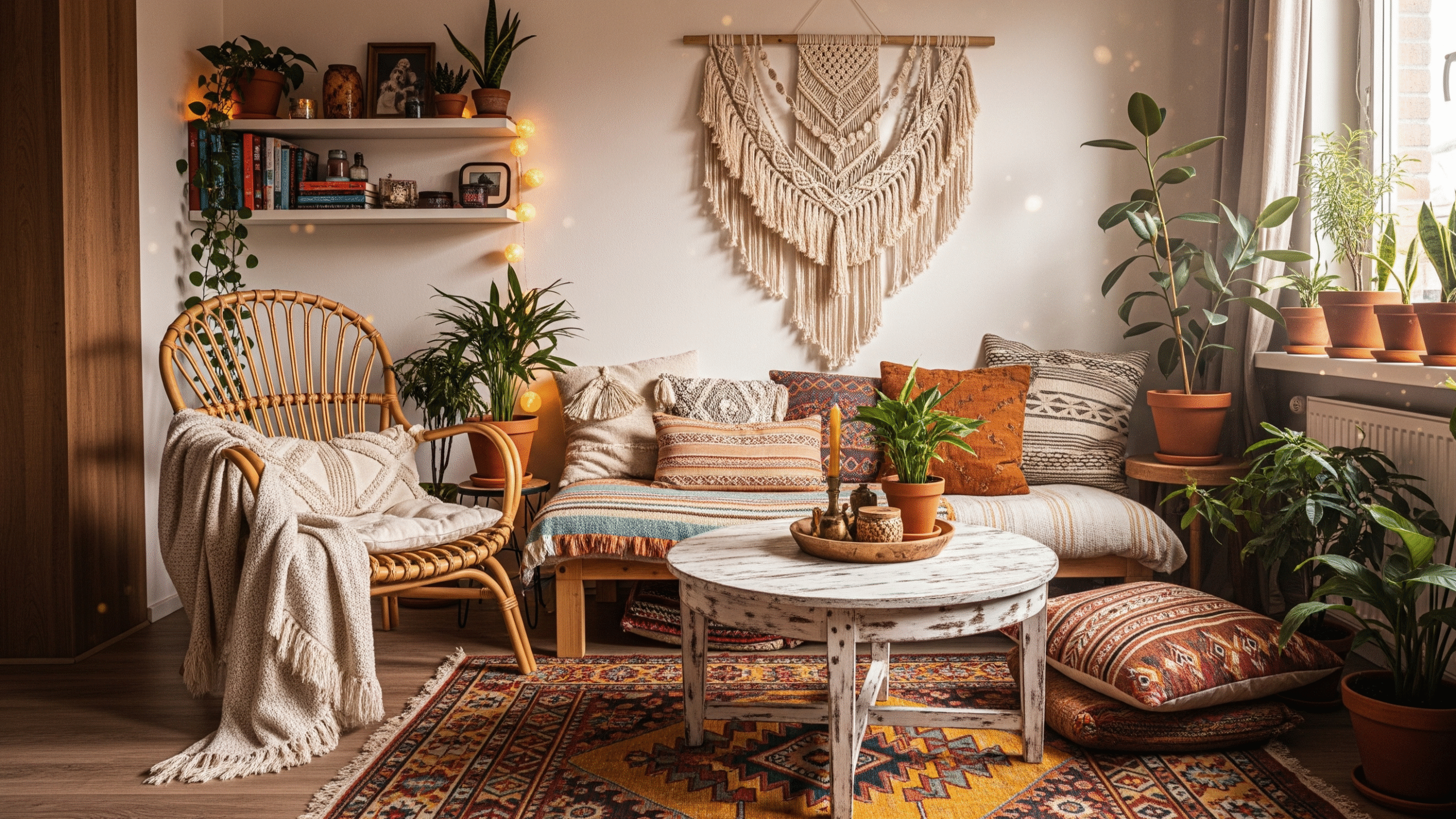
7. Personalize with Minimal Decor
When decorating a small apartment, it’s easy to go overboard and make the space feel cramped. Instead, choose a few meaningful decor pieces — framed art, travel souvenirs, or Unique Ceramics — to give the room personality without overcrowding it.
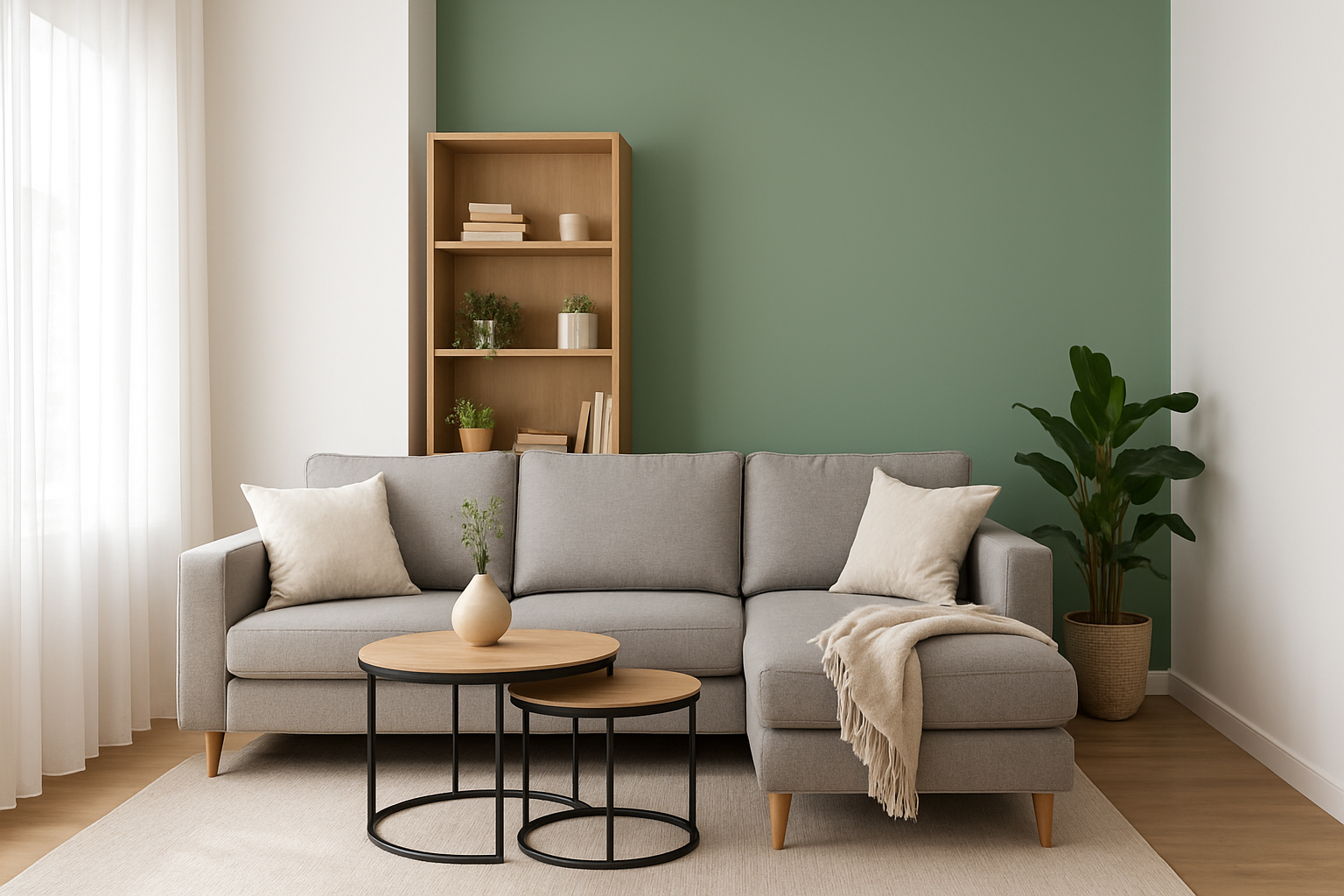
8. Play with Lighting Layers
Good lighting can make a big difference in a small living room. Combine different lighting sources like floor lamps, table lamps, and wall sconces to create a cozy atmosphere. Avoid harsh overhead lighting and opt for warm, soft bulbs to make the room inviting.
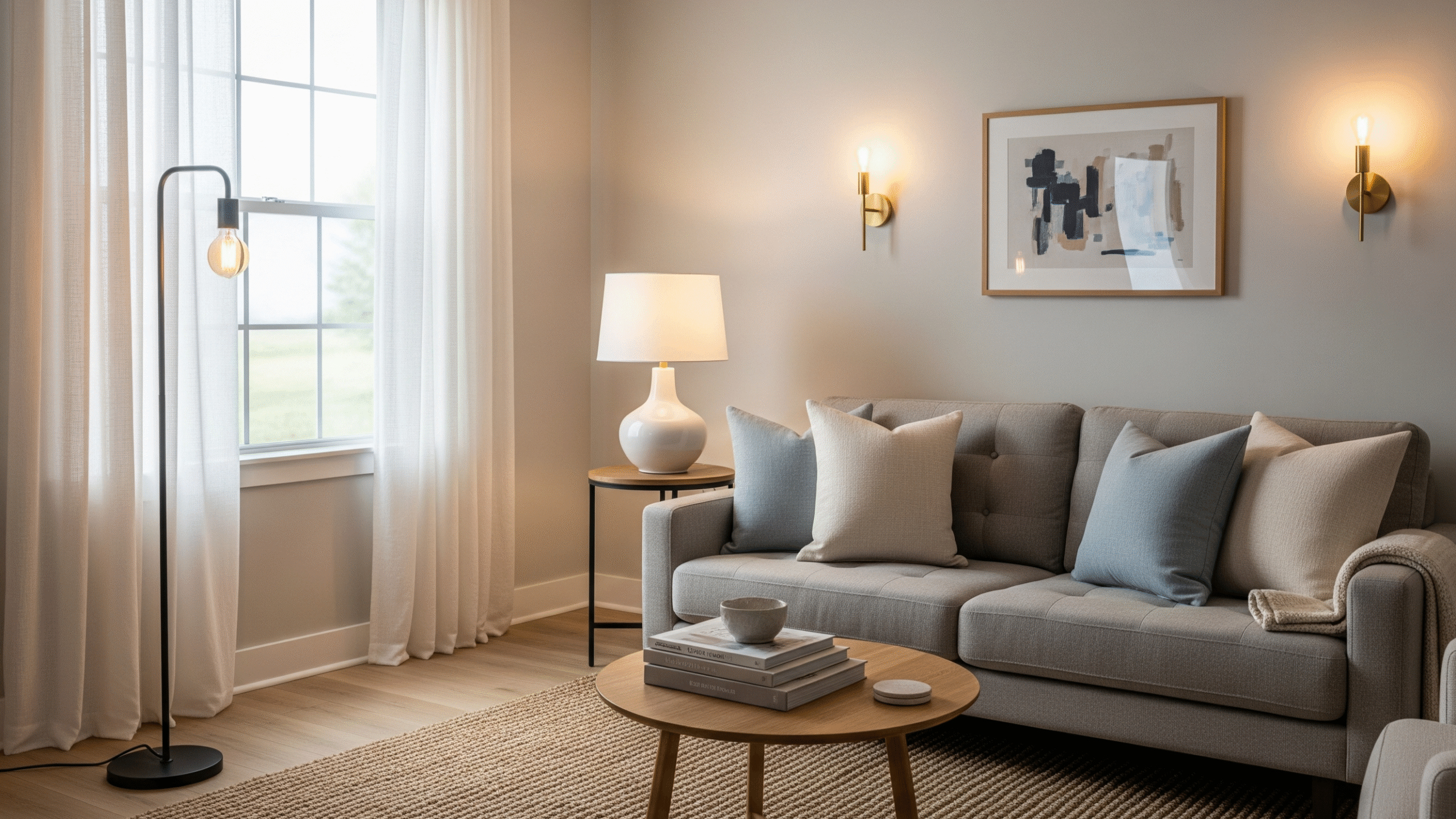
9. Go for Space-Saving Entertainment Units
Instead of a bulky TV stand, consider wall-mounting your television. Pair it with a floating media console or slim shelving unit to keep the floor clear. This setup not only saves space but also gives the room a sleek, modern feel.
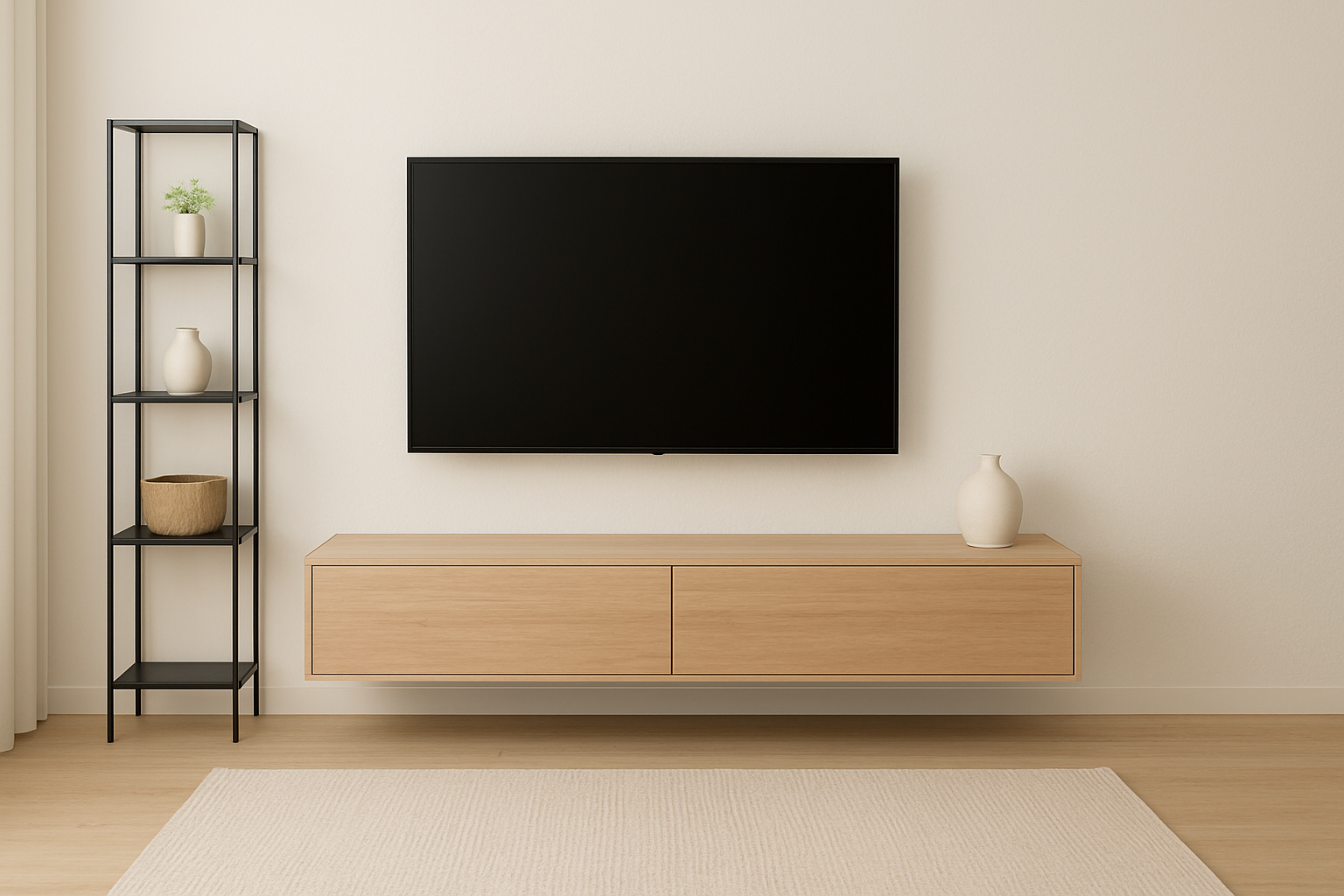
10. Keep It Organized
Finally, the key to maintaining a functional small living room is organization. Use baskets, hidden storage compartments, and under-sofa storage to keep clutter out of sight. A tidy space always feels bigger and more comfortable to live in.
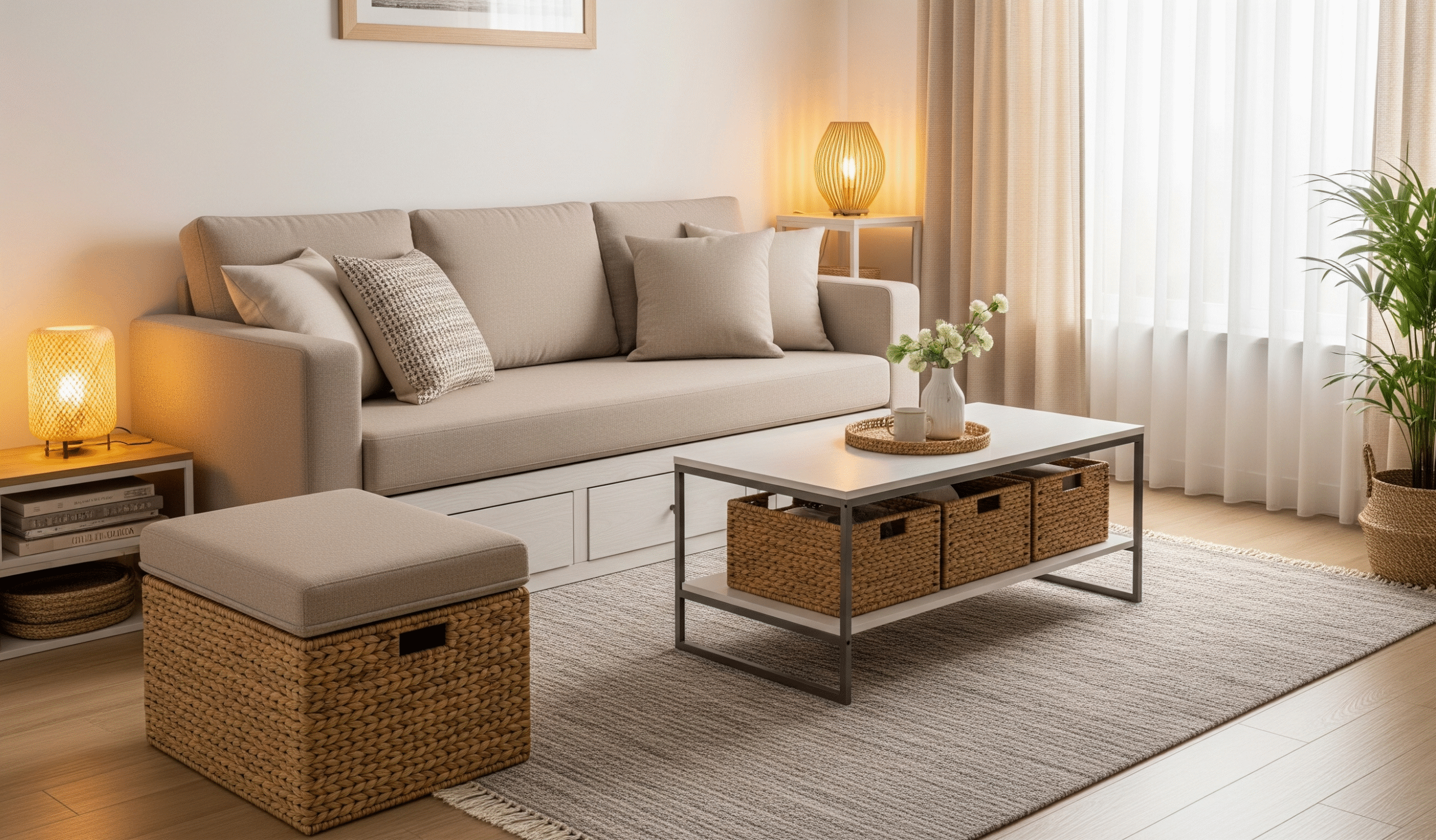
Conclusion:
Your apartment’s small living room can be just as beautiful and functional as a larger space — it’s all about smart planning, creative solutions, and intentional design. By using light colors, multifunctional furniture, vertical storage, and thoughtful decor, you can turn your compact living area into a stylish, comfortable haven you’ll love spending time in. With these small living room ideas apartment tips, you can create a space that’s both practical and full of personality.